Australian Terrier International Meeting The Needs Of Aussie Owners Globally © 2010 Australian Terrier International
May, 2011- Vol. 2, Issue 4
|
|
|
|
|
|
Dear Aussie Friends, | |
This month we are delighted to bring you the wonderful Aussies of Sweden.
We continue to question where are we going as a breed? With insightful answers from top breeders around the world, we hope to encourage that conversation around the globe.
Most importantly how do we maintain and improve the health of our dogs? We continue to provide alternative ideas that may help us in achieving those goals.
The breeder can health test the mother and father dog but what can we do as pet owners to maintain the health of our puppies once we get them. We continue to explore those ideas as well.
We hope you are having a wonderful summer with your dogs. Happy reading! Stay safe!
Pamela Levy
ATI Founder and Editor
|
Feature Family
| |
This month we are featuring
Nellyson's Kennel of Sweden.
To read about Tina Nordgren and to see a slide show of her beautiful dogs, please click here.
You can contact Tina directly by
clicking here
To view her website
click here
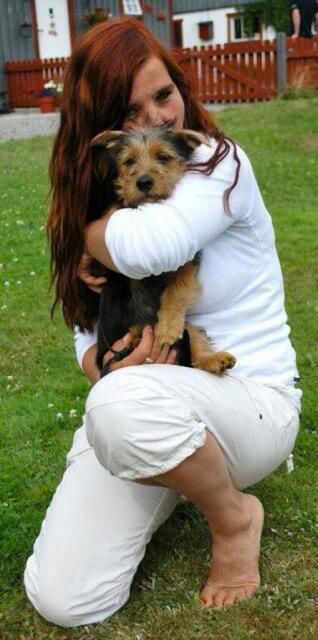
Tina Nordgren
|
|
|
|
The History Of The Aussie In Sweden By Carin Sandahl | |
The first Aussies came to Sweden through Denmark in the early 1960´s. In 1963 the first Aussies entered at a show. It was the Danish imports Stella Polaris Cassiopeja, Steffi Pride and Stella Polaris Jupiter owned by Stebs kennels. The first litter was born and registered in 1964 at kennel Stebs.
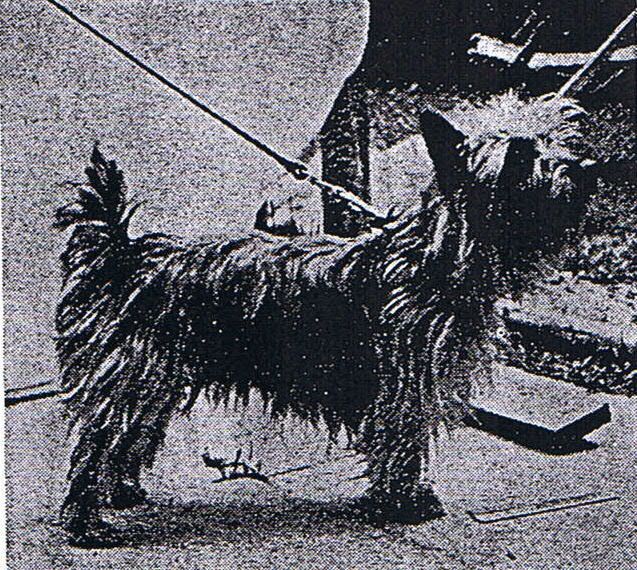
Stella Polaris Stardust
Another early pioneer was a sea captain named Karlsson, who fell in love with the breed during a stay in Australia. In 1964 he brought home the male Narrung Roger Dean to Sweden. He became Swedish Champion.
In 1969 he brought home a bitch, Narrung Ses Sprite, who later whelped two puppies by Roger Dean.
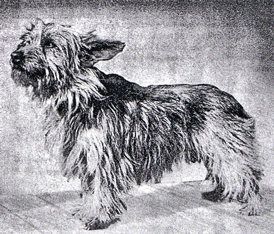
Elvyne Bewitched Tina
Other dogs were imported from Denmark by the countess Birgitta Mörner. She bought the bitch Stella Polaris Ceres in 1965. Raminas kennel bought the bitch Busses Harsh Juditha from Finland in 1966. A few other kennels started and bred a few litters and then disappeared. Mrs Ingeborg Brännland, Bianceborgs kennel, took over kennel Stebs dogs and bred them under her own prefix Bianceborgs from 1969 to 1973.
Mrs Renata Nilsson, kennel Reni´s, was the most successful and dominating breeder during the 1970´s and 1980´s.
She built her breeding on several imports from Australia. In 1975 came her first import, the male Ch Bonzer Just Fred, who was the father of several winning dogs from Reni´s kennel. She also imported the dogs Ch Hfarmist Here I Am, Ch Negura Billy Buttons and Ch Tonee Town Twistnriggle.
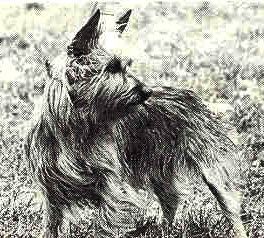
Agrippas Debbie
The first dog to become an International Champion was Int & Nord Ch Blue Benjamin, bred by Lars and Birgitta Hellkvist, who later took the kennel prefix Bikarol.
Bernt Bolin, kennel Cooctown, brought home two male puppies from a trip to Australia in 1987. They were Taralee Small Potatoe and Llandrow Pegasus. Both became champions but Pegasus was the one most used and he left some nice champion offspring at Cooctown kennels.
Someone who had a big influence on the Swedish Aussie breeding was Mrs Anne-Marie Hamilton Bartter. She was born in Sweden, but married an Australian and lived there for 25 years. She decided she wanted to do something for the Australian Terrier in Sweden, so in 1985 she brought with her the bitch Ch Tahee Charade, who was mated in Australia and had a litter in Sweden. The puppies were sold to breeders in Sweden, Denmark and Finland and their line can be found behind lots of Aussies today. In 1987 Anne-Marie came back to Sweden with the male puppy Tahee Night Hawk and the bitch Ch Tahee Special Girl. They produced a litter in Sweden and again the puppies were sold to breeders in the Nordic countries. The only bitch puppy was Ymsens Yarrawonga, who was one of the foundation bitches at kennel Twee-Dle-Dee.
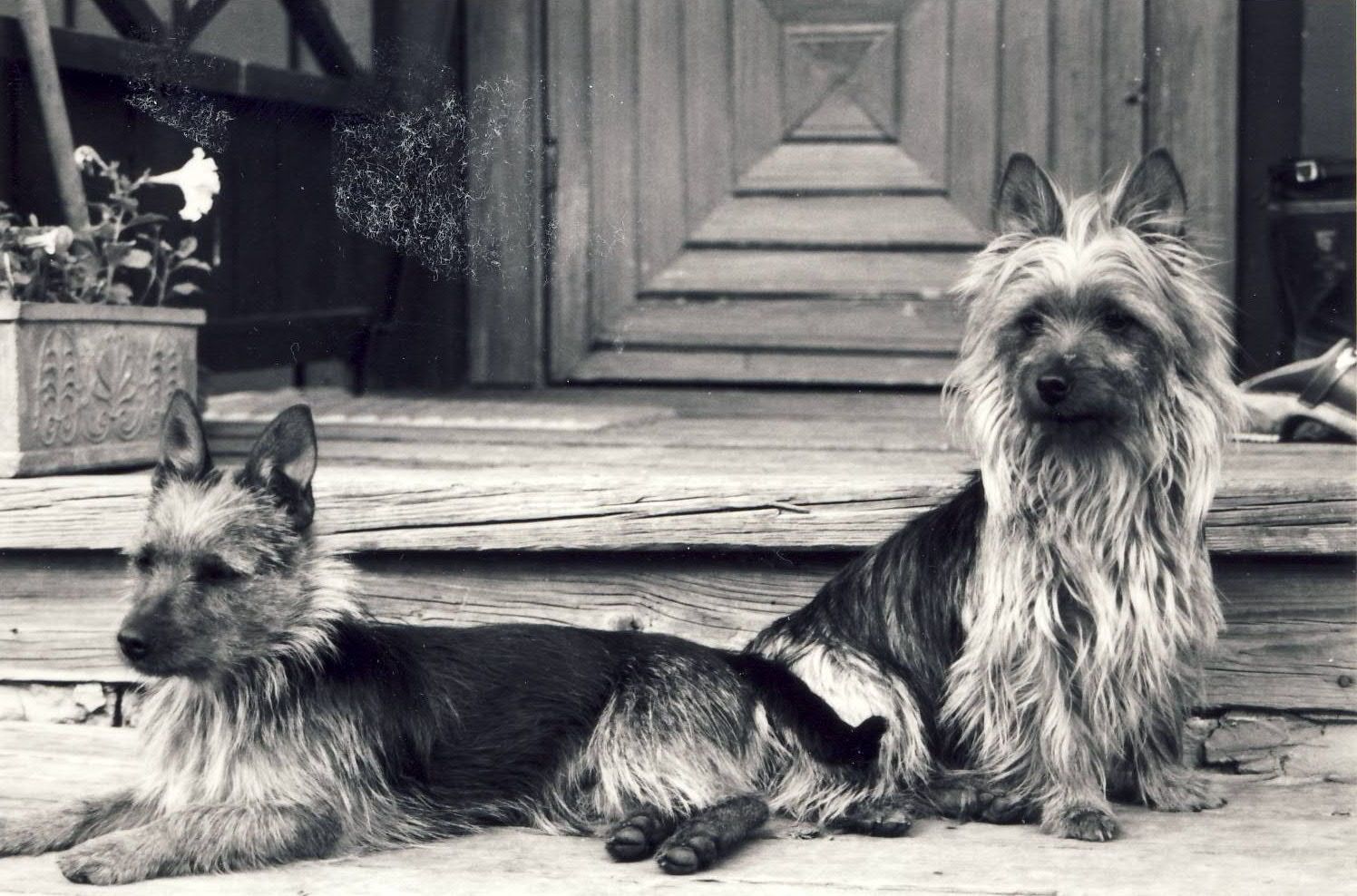
Two Dogs From Sweden In The 1980's
She built her breeding on several imports from Australia. In 1975 came her first import, the male Ch Bonzer Just Fred, who was the father of several winning dogs from Reni´s kennel. She also imported the dogs Ch Hfarmist Here I Am, Ch Negura Billy Buttons and Ch Tonee Town Twistnriggle.
Tahee Special Girl went back to Australia with Anne-Marie and became Australian Champion and obedience champion.
She was later mated to the famous Ch Tahee Dirty Harry. Anne-Marie kept the male Wyangan Storm Petrel who became Australian Champion. When Anne-Marie became seriously ill Storm Petrel was sent to kennel Winthertorpet in Sweden.
The oldest active kennels in Sweden today are Cooctown, Bernt Bolin, Vitterklippen, Ulla-Britt Norgren and Twee-Dle-Dee, Carin Sandahl, who has been breeding for almost 30 years.
The most winning kennel name in the show ring is Jaskarin, Saija and Markus Walldén, who moved to Sweden from Finland about 10 years ago. But there are several new breeders coming on and the breed is growing here in Sweden, so we look upon the future with confidence.
|
Honoring Carin Sandahl Of Twee-Dle-Dee Kennel | |
It is an honour to see an article about a breeder colleague who, in my opinion, has made great contributions for the development of the breed. She is Sweden's first lifetime member and I cannot imagine anyone that deserves it more than she does.
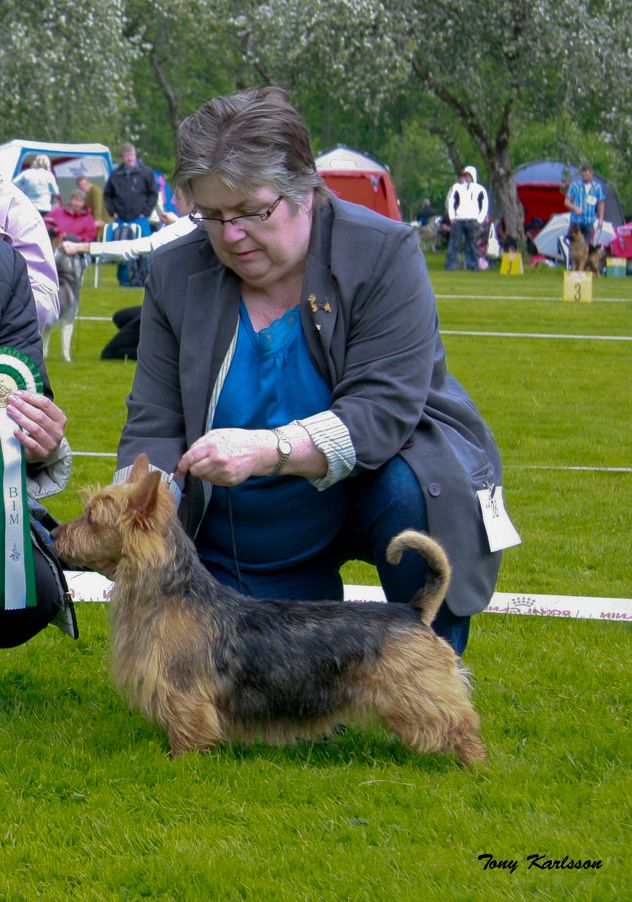
Carin showing Twee-Dle-Dee With Makeup On
Karin has always had the best of the breed in mind and is always ready to help and give valuable advice for breeders and hobbyists alike. She has generously shared her blood lines to ensure the future of the Australian Terrier in Sweden. Many kennels have borrowed a Twee-Dle-Dee male and many have a Twee-Dle-Dee bitch in their pedigrees.
The blue-and-tan colour has a special place in Carin's heart and therefore she has chosen to specialise on blue-and-tans. Aside from her kennel, Carin has been involved in the Swedish club of the breed and spent numerous hours on non-profit work. She was also the chairperson of the club.
In 2011 Carin and undersigned wrote a book of the breed, Aussieboken (Swedish for The book of Aussie), to compile and share all that we have found and discovered about the breed during our years as breeders.
Thus, in what better way could I present her breeding than by an extract from Aussieboken? I hope that we will see a lot more Twee-Dle-Dee-dogs in the future since Carin has an extraordinary feeling for the breed. She has a healthy attitude to the world of dog shows and does not let herself be fooled by the whims of fashion. Her motto has always been a well-composed dog without exaggerations.
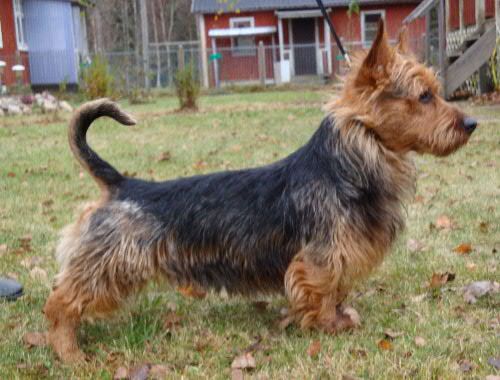
"Bobo" Twee-Dle-Dee Thru The Looking Glass
Carin and Roger Sandahl first began breeding poodles but became so fascinated by an article of the breed published in Hundsport (a Swedish dog magazine) in 1983 that they bought their first Australian Terrier the following year. The newly acquired Aussie was the bitch puppy Ch Sassatown Laughing Imp from Finland. Carin later mated her in 1985 with the Finnish male Ch Juuso von Bienehof and she became the mother of the first Australian terrier litter of the kennel. Carin also bought Ch Ymsen's Yandilla in 1985 and in 1987 she bought Ch Ymsen's Yarrwonga from the true Aussie-enthusiast Anne-Marie Hamilton Bartter, who had Ymsen's kennel in Sweden and Wyangan kennel in Australia.
Ch Ymsen's Yandilla had three litters, 1987 with Reni's Äxtra Strong, 1988 with Ch Trolding's Kerry and in 1991 with Ch Twee-Dle-Dee Tophat's Tail. Several of her offsprings became Swedish champions and were used in breeding. Yandilla herself became 14 years old.
Ch Ymsens Yarrawonga left four litters. The successful siblings Ch Twee-Dle-Dee Knockout Drops, Ch Twee-Dle-Dee Good Vibrations and Ch Twee-Dle-Dee Punch-Line was born in Yarrawonga's second litter. Yarrawonga became mother to seven champions all in all.
In 1991 another bitch from Anne-Marie Bartter joined kennel Twee-Dle-Dee. This time the bitch was born in Australia and came from Anne-Marie's last litter. Her name was Ch Wyangan Banksia.
I n 1993 a couple of Carin's first Australian Terrier CH Sassatown Laughing Imp's grandchildren was born in Norway. The mother of these puppies was Ch Twee-Dle-Dee Tribute To Norway and the father was the from England imported male Zellamere March Past Brimartz. The same year the kennel bought the bitch
Ch All The Best. Funnily enough, also she became the mother of seven champions, among them the male Ch Twee-Dle-Dee Join The Circus (after the Australian male TineeTown Tryiton) and the bitch Ch Twee-Dle-Dee Take All Of Me (after Ch St.Capes Black Bumpkin). Carin chose to keep these two in the kennel.
Take All Of Me upheld the tradition and became the mother of seven champions. Another of All The Best's sons, Ch Twee-Dle-Dee Banana Bender (after Ch Bluepepper´s Terri-Er) moved to kennel Bluepepper's in Finland.
In 1995 the male Ch Rebelglen Time Bandit was imported from Australia but to Carin's and Roger's great disappointment Time Bandit turned out to be sterile, and was given to Carola Eriksson/Per Berg who showed him quite a bit and he became, among other things, The Aussie of the Year in 1996. There were other rules and regulations concerning importing dogs at that time and there was great deal of drama when he travelled to Sweden.
In 1996 the bitch Ch Bluepepper's Milla Magia was bought from Finland and in 2003 the bitch Ch Tatong's Heavenly joined the kennel and in 2005 the male Ch Tatong's Spy In The Sky came from Denmark. The kennel has exported dogs to all of the Scandinavian countries and to USA.
Ulla-Britt Norgren
Translated Sara Norgren
|
An Interview With Lifetime Member Carin Sandahl | |
This month ATI welcomes Carin Sandahl as the first
Lifetime Member from Sweden.
We want to congratulate Carin and thank her for her years of
dedication to the breed.
The Kennel name Twee-Dle-Dee is behind many top winning
Swedish and International dogs.
Thank you so very much! It is a great honour to have become an ATI Lifetime Member and it feels really overwhelming. I'm very happy and flattered.
I can really feel it´s a small world, and that ATI is a fantastic organization that ties us Aussie-lovers together all over the globe. I am proud to be a part of it!
Carin Sandahl
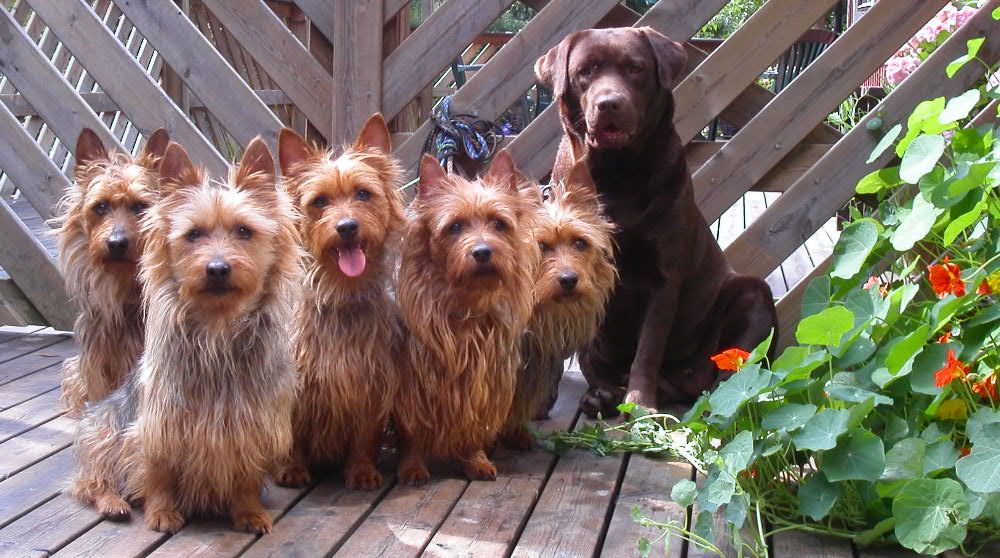
From the left: Ch Tatong's Spy In The Sky, Ch Tatong's Heavenly, Ch Twee-Dle-Dee Without Makeup, Ch Twee-Dle-Dee Laughing Face and Twee-Dle-Dee Dark Angel.
How did you get involved or started with Australian Terriers?
I was breeding standard poodles for some years and wanted to try a smaller breed as a complement to the work-demanding poodles. I found a long article about Aussies in the Swedish Kennel Club Magazine in 1983. Both my husband and I became very interested and visited a breeder to see Aussies in real life and get to know more about the breed.
That year, 1983, only 13 puppies were born in Sweden and after that article in the KC Magazine all the puppies were sold. Later that summer we took one of the poodles to a show in Norway and ran into a man with two Aussies. He turned out to be Mr. Harto Hallikas, of kennel Sassatown, from Finland. We kept in contact and the year after we were offered the best bitch puppy in a litter he had. Her name was Sassatown Laughing Imp, a tough little girl with a big personality. She later became our first Aussie champion.
We just loved the breed and slowly we ran out of poodles and ended up with only the Aussies.

Sassatown Laughing Imp did not love getting her nails done.
How did you choose your kennel name?
That was when we started with poodles. I bought my first bitch pup from another breeder and could chose a name beginning with T and somehow came up with Twee-Dle-Dee, which I thought suited the poodle mentality. She was Creols Top Twee-Dle-Dee. When I decided on my own kennel name it was an easy choice.
How many years have you shown Aussies?
Since I got my first Aussie in 1984.
How many years have you been breeding Aussies? We had the first litter in 1985, so that is 27 years this year. 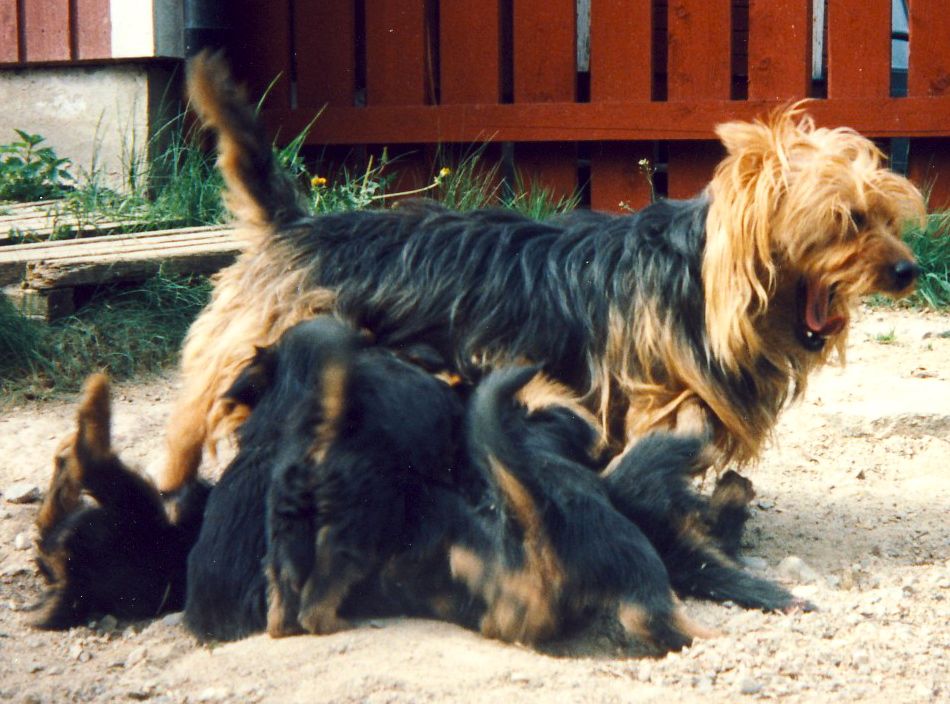 How many litters have you bred? I just had Aussie litter number 46, and we also had 10 litters of standard poodles. Do you know how many champions you have produced? I know it is at least 40 Aussie champions, but I might have overlooked someone. Do you enjoy mentoring other people in the breed? Yes I do. I think it is important to pass on the knowledge you have gathered during the years. We want the breed to live on, be true to the standard, healthy and to have the wonderful temperament it has today. To achieve that we have to help and mentor the new and upcoming breeders so they can continue our work into the future. Who were the people who mentored you in the breed? After I bought my first Aussie from Harto Hallikas, we kept in contact via old-fashioned letters (before e-mails) for some years and he taught me a great deal about the breed. The rest I had to learn myself. What do you look for in the bitch to make her worthy of your breeding program? Health and temperament of course, but that comes without saying. She should be well constructed with good proportions and good bone, good angulation and a good carriage with long neck if possible. A long head with good muzzle and expression is also important. Coat and colour - the wish-list could be long. You can´t get all you want in one dog, but I want her as near my ideal as possible. What do you look for in the stud dog to make him worthy of your breeding program? About the same as in the bitch, but I try to make him complement the bitch and have the benefits that she lacks and vice versa. I don´t look so much at the pedigrees when I breed, except to make sure the two are not too closely related. I look more for type and try to find dogs as close to my ideal Aussie as possible. Can you define your idea of breed type? I think it´s important to keep in mind for what purpose this breed was once made and pay attention to the standard when you create your ideal Aussie in your mind. It should be a "low set, sturdy dog" robust enough to be able to work most of the day. He has to have a good chest and body to support lungs and heart. He can´t be too weedy or too heavy to do his work, but have medium bone. He needs a long head and strong muzzle with good bite to catch rodents and snakes and he must have those quick reflexes and alertness to do so. Good coat quality is also important. A too soft coat was not practical in the outback. A good carriage and a long neck make this sturdy dog quite elegant and pretty to look at. What have been your proudest moments in the breed? That is difficult. There have been so many proud moments through the years, but one memorable moment was when the blue/tan male Ch Twee-Dle-Dee Knockout Drops won BIS at our National for the fourth year in a row. He won 1991 to 1994 and was the most winning Aussie in the Swedish rings at the time.  BISS Ch. Twee-Dle-Dee Knockout Drops How did you learn to groom? I had done a lot of dog grooming earlier, and not just poodles, which is a totally different type of grooming, but also some terriers like Airedale, Welsh, Cairn, so I knew what terrier grooming was about. However, there was nobody nearby that could show me how to do an Aussie, so I had to learn that by myself. My first Aussie had a very harsh coat that did not grow much and was easy to keep tidy. At the same time I looked at photos of good Aussies and talked to people at shows and looked how their dogs were groomed and tried to copy the good parts at home. Slowly I learned how I wanted an Aussie to look and how I wanted it groomed. Have you exported Aussies? Yes, I have exported to Norway, Finland, France and USA. Have you imported Aussies? Yes, from Finland, Australia, Norway and USA. Do you see a difference in personalities between dogs from other countries and dogs from Sweden? I don´t think I have enough experience to say there is a difference between countries. I have a feeling there can be a slight difference between different blood lines. But then again every dog is an individual, so that is hard to say unless you get to know a larger number of dogs from different countries. Did you find it difficult to produce a nice natural tail? Yes, I think it will take some time before we see only nice and straight natural tails. If you could breed only on the look of the tail you could probably have straight tails in 2-3 generations, but in a small breed like ours you have to consider the whole dog, and you cannot afford to take an otherwise good and healthy dog out of breeding just because his tail is a bit curled, so my guess is that we will continue to get both straight and curled tails in the litters for quite a while. Unfortunately you can´t say for sure what the tail will look like on the grown dog until the puppy is 3-4 months old. It can change when the pup grows. Can you describe what a good natural tail should look like? I think the best way is to show it with photos. 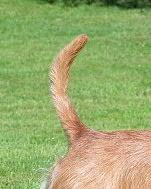
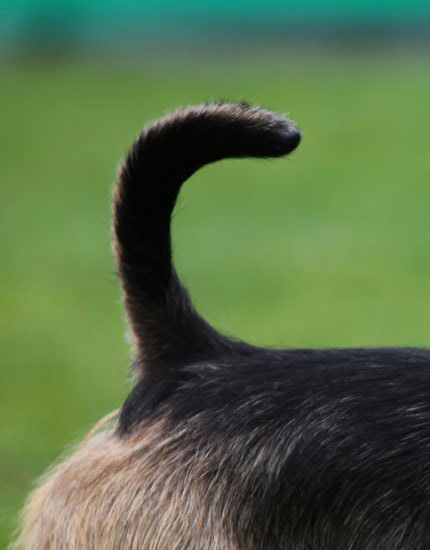
Do you have a few favourite Aussies that you owned or bred? All the Aussies that have lived here with us have been favourites and loved for their personalities and the individuals they have been. I cannot say that one has been more of a favourite than the others. If you mean best show dogs I have bred, those who are closest to my ideal Aussie, I would mention the male Ch Twee-Dle-Dee Join the Circus. He was a handsome boy, well built with a lot of style and reach of neck, dark colours, and he moved very well. In bitches Ch Twee-Dle-Dee Take All Of Me was a very pretty bitch with a very good front and unusually good neck and carriage for that time. Today I have her great grand-daughter Ch Twee-Dle-Dee Without Makeup, who not only is a successful show dog, but also a fantastic brood bitch, who whelps her big litters without problems and who is the best possible mom to her puppies. 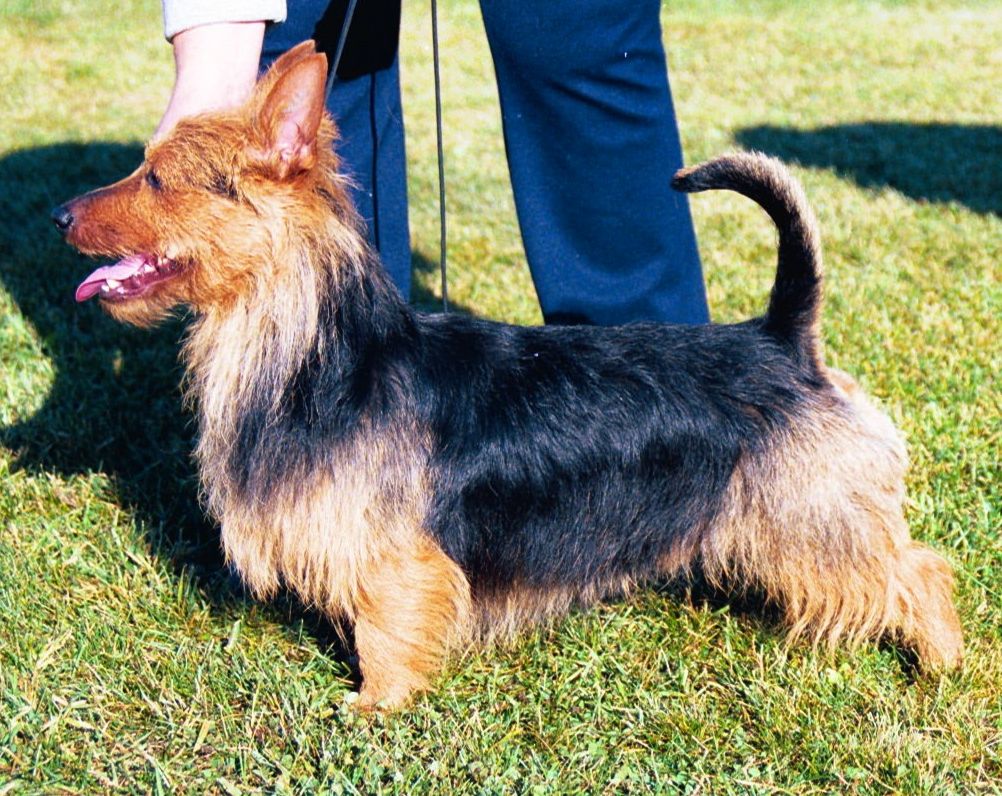
Ch Twee-Dle-Dee Join The Circus 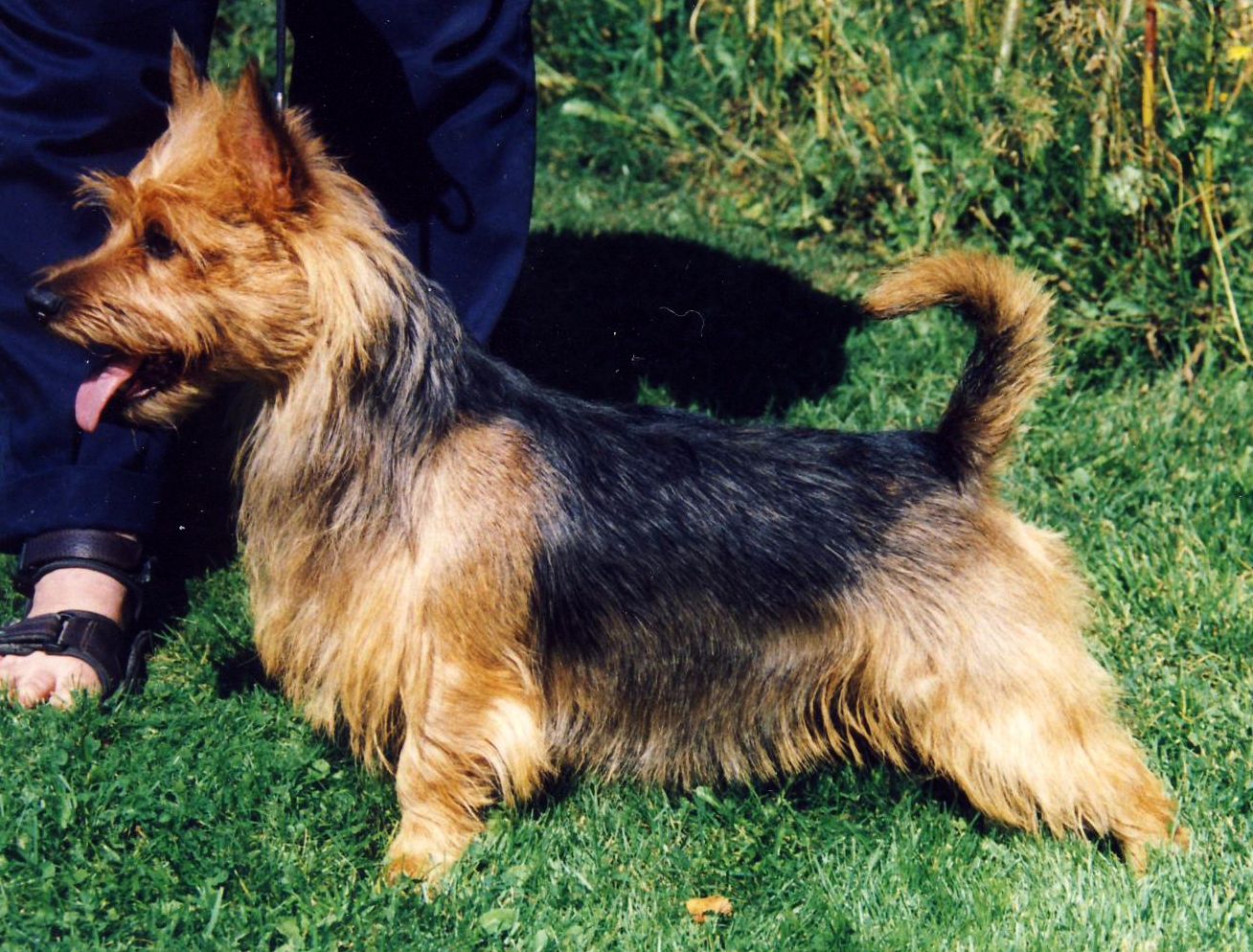
Ch. Twee-Dle Dee Take All of Me 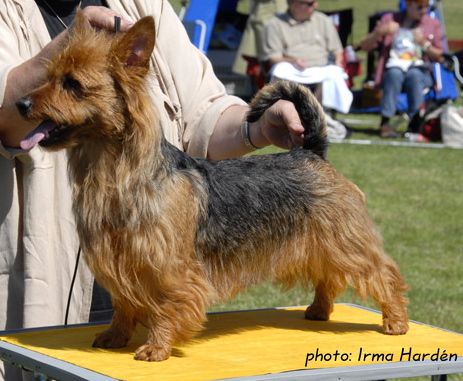
Ch Twee-Dle-Dee Without Makeup How has the Aussie changed since you started breeding? Here in Sweden I think it has changed a lot for the better during my 27 years. Backs and top-lines are much better, tail-sets and hind angulations are a lot better. Fronts are better but could be better still. We don´t see many triangular heads anymore and most dogs have all their teeth, which was not the case earlier. I also think the temperaments are better. What concerns you about the Aussie of today as it relates to conformation and health? As I said the Aussies here have improved a lot during my time, but we have to keep on working with the fronts. Shoulder/upper arm angulation and straight front legs could be better. When it comes to health, I think we have very few problems compared to most breeds. There are very little knee problems; cataracts are very rare. There are a few cases of thyroid diseases and sometimes a case of allergic reaction. The biggest problem must be older dogs that get diabetes. What have Aussies added to your life? My Aussies ARE my life. I live with them and sleep with them and they are my first priority all the time. I am surrounded by them all the time at home. Because of them I get to meet a lot of interesting people and go to a lot of places for shows. To watch the dogs interact with each other, play and do crazy things is so amusing, and to experience the very special bond between me and the dogs is priceless.  Ch Twee-Dle-Dee With Makeup On is using our Labrador to get a better view through the window. You recently published a book about Australian Terriers. What made you decide to write a book and can you tell us a little bit about it? There is nothing written about Australian Terriers in Swedish, and my puppy buyers now and then ask me about where they can read about their breed. So the idea to write a book came up years ago. When I talked about it with my friend and fellow breeder Ulla-Britt Norgren, Vitterklippen kennels, we discovered that we both had the same idea and decided to do it together. We started breeding Aussies about the same time so we both have a long experience of the breed in Sweden. We decided that our book would only be about the breed, what it´s like, what you can expect living with an Aussie, stories about Aussies told both by us and by our puppy buyers, the breed history and of course lots and lots of photos. We decided not to take up space with "how to breed" or "how to train your pup" - things you can find dozens of books filled with. We wanted to pass on information about the breed that we have gotten from breeders before us and that we don´t want to be forgotten. We have only received positive response so far, so hopefully we have succeeded in creating the book that we wanted. We had a lot of fun doing it. Most importantly, with all you've done and your years of dedication to the breed...... How would you like to be remembered in the breed? As somebody who was breeding good and healthy Aussies that can be an asset to have in the pedigrees in the future, and as someone who always had the best of the breed in focus and not my personal success.  |
The Australian Terrier Book | |
ATI could not be more proud of members Carin Sandahl and Ulla-Britt Norgren.
They have published the first book, ever written in Swedish, about Australian Terriers. Congratulations to them for this amazing accomplishment. Now if you can't read Swedish, this book is full of wonderful Aussie photos that are sure to delight you.

A note from the authors:
We have had the lovable and tough Australian terrier in Sweden for almost fifty years but it is not until now that the breed has got its own book in Swedish. Two of the breed's most loyal breeders have compiled experiences and material which have been collected for decades. In this book you will find information which has never before been published in Sweden. The book contains, for example, the history and the development of the breed, grooming description and anecdotes about owning an Australian Terrier. These stories are both humorous and heart-warming. The book is both for the beginners and for the out-and-out enthusiasts of the breed. The book is written in Swedish but contains a lot of beautiful photos.
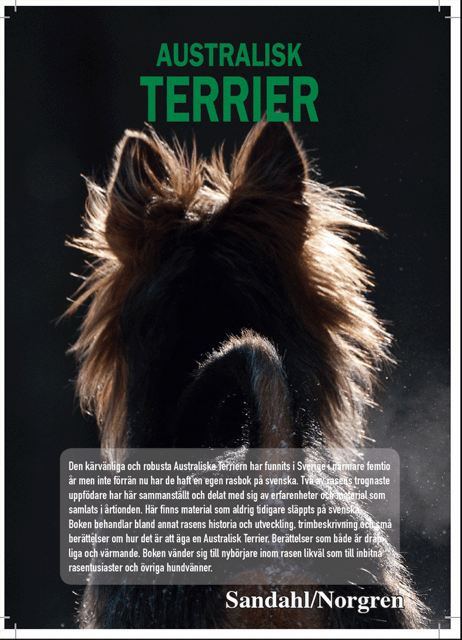
|
Gallery Of Swedish Aussies | |
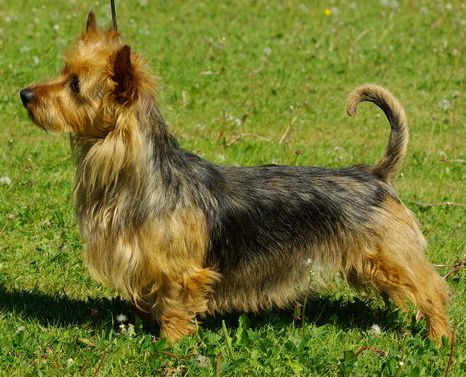
Photo Courtesy of Birgitta Sundell
NO UCH SE UCH Ålhammarens Ruzzin
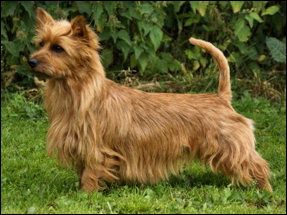
Photo Courtesy of Birgitta Sundell
NORD UCH Ålhammarens Ruffa Koppartroll

Kille = NORD UCH Övikspojken Av Falchebo
(NEJ UCH SE UCH Vargtass Av Falchebo /NORD UCH
Tinee Town Thequeenoharts)
Owner: Vitterklippens kennel
Breeder: Marthe Falch Norway
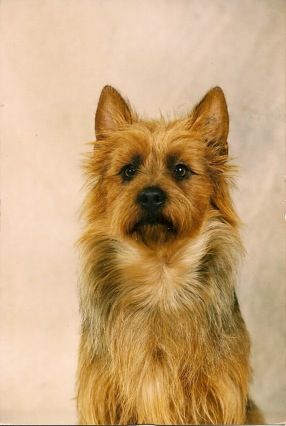
Baccus = SE UCH, SE V-03 Vitterklippens baccus
(NORD UCH Övikspojken Av Falchebo /Vitterklippens Wissla)
Owner: Forsén Hans-Erik
Breeder. UB Norgren
|
"Amorina" By Sara Norgren | |
"Amorina"
The Aussie on a Constant Involuntary Diet from "Aussieboken"
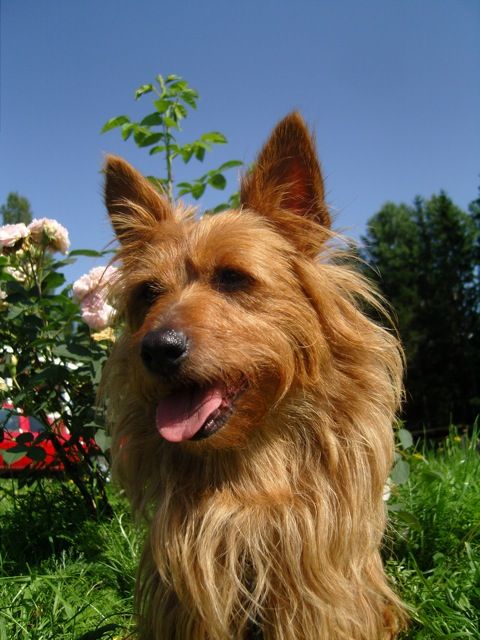
Vitterklippens Amorina is the undisputed ruler, legislator and police woman of our house. She considers herself to be the complete polity of the kingdom of Vitterklippens kennel. That is the way she has always been, although now when she is older she has also become a lot more stubborn, more unforgiving as well as selectively deaf, which basically means that she hears what she wants to hear. This is a phenomenon that we call the seniority effect (after my dear grandmother who displays these characteristics to an ever increasing extent as she gets older).
Another recurring characteristic of hers is a tendency to gain weight quickly and to lose excess weight slowly - considerably more slowly than the actual weight gaining - and this is not helped by the fact that she steals other dogs' food as soon as she gets any kind of opportunity. This means that we have been forced to attempt to make her slim down numerous times, something which is unappreciated both by "Amorina" and by her surroundings. She gets cranky, moody and since necessity is the mother of invention, extremely inventive and resourceful. As her servings get smaller she becomes increasingly desperate and tries to steal food or terrify the rest of the dog population into abandoning their servings. This means that we have to confine her to a room during feedings or guard her constantly. For the last solution to be completely effective at least two people are needed.
She does not hesitate to steal food from puppies - not even from her own - or to steal the food of the cats (despite them being armed absolutely everywhere!). Countless of times have we glimpsed a long red tail sticking out from a tilted bag of cat food. To yell at "Amorina" is meaningless, since she does not understand that anyone could possibly be mad at her and, surprised at the raised voices, she starts looking around for the target of what she considers to be a completely unfounded anger.
She has never been unintelligent either and therefore she quickly figured out that the food we give our dogs comes from the white box with a flip top lid. We could not figure out how she could be so extremely overweight despite us giving her small servings, confining her to a room during feeding and relocating the cat food into a barrel with a type of burglar proof lid that we had considerable difficulty opening ourselves. One day my mother walked past the room where we keep the dog food (with a gate high enough to prevent "Amorina" from jumping over, especially at her current weight at that time) and heard a sound coming from the white plastic container. It was the unmistakable sound of dry dog food being transferred in large quantities. She looked into the room and saw a long, red tail sticking out from the lid of the white box. Suddenly the mystery behind "Amorina's" weight problem was solved. She managed daily to get past a gate (which she should not be able to handle), open the lid on the plastic box and crawl inside to eat at her own "all you can eat buffet" and also avoid being caught red handed. I am sure that she would have been an extremely skilled criminal - either as a burglar or the leader of a coup d'état - had she not been a dog of course. Sara Norgren
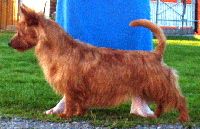
|
Belly Bands by Ulla-Britt Norgren | |
Bellybands are a way to show concern about oneself, others and one's dog.

I started making bellybands to help others who had problems with male dogs that tended to mark their territory even inside the house or when they brought the dogs with them during visits. Bellybands could be bought in most pet shops but why did they have to be so very ugly and fit the dogs so poorly? That actually got me thinking and I started making belly band patterns since the fit of the belly band varies according to the bodies of the breeds. A greyhound cannot have the same belly band as a pug.
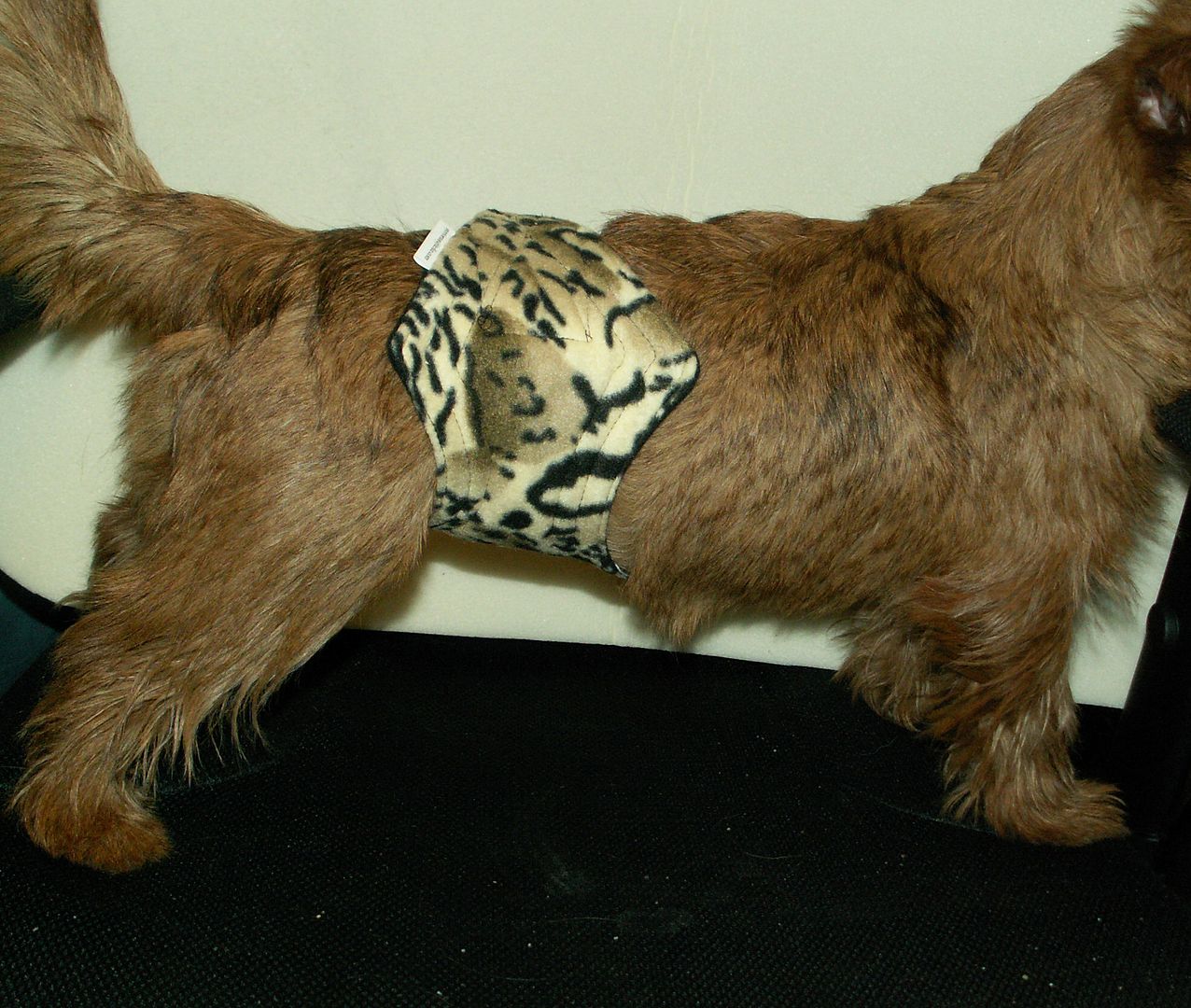
For bellybands fitting our breed I have, naturally, had many to try the models on and I have personally made a couple of bellyband-models which I think fit our breed perfectly.
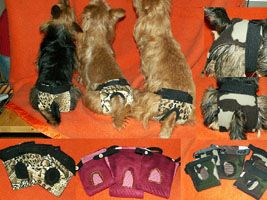
The bellyband should be used to prevent accidents and as an attempt to get rid a bad habit. They can never be used as a way to get out of walking the dog. You also have to exclude other potential reasons for the peeing.
Used properly, the bellyband is a wonderful aid to hinder marking male dogs and it enables you to bring the dog everywhere. But, to be fair, there are also bitches - who have their seasons - and I also make pants for them.
I think that it is important to not be ashamed of your dog but to take responsibility for its actions.
Wise words from male dog owners:
"I am not going to be ashamed of the fact that my dog sometimes lifts his leg to mark. However I chose to take responsibility for the fact that he might do that and therefore I use a bellyband."
"If I bring my dog to places where there are a lot of smells, then his instincts take over and he sometimes pees on inappropriate places. It is not especially fun for me or for the person I happen to be visiting. Now I always put on the bellyband when I visit someone which means that both my dog and the person I am visiting are much less tense."
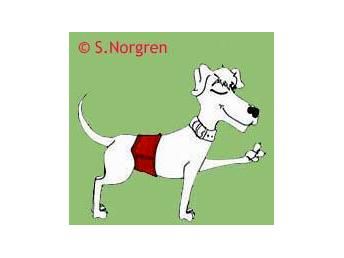
Care of The Bellyband
Wash the bellyband in 30-40 degrees Celsius. Do not choose harsh centrifugation. Remember to attach the Velcro tape, otherwise they will get stuck to each other or other items. If you have any buttons, button them.
After washing, either hang them and let them dry by themselves or dry them on low heat in the dryer. Think about the hygiene and change the insertion, if you use one, often.
|
Photos, Photos, Photos from Ulla-Britt Norgren | |

Vitterklippens Kalmus
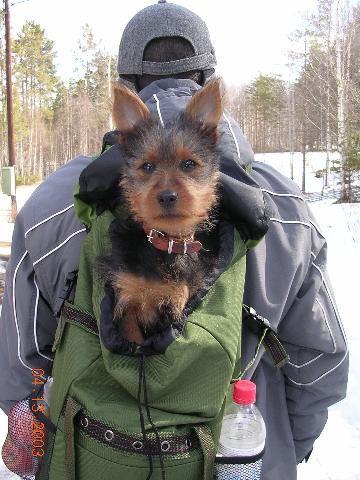
Vitterklippens Blondie
Owner: Kennel Stebas

Vitterklippens Myran and Vitterklippens Lindy-Sue
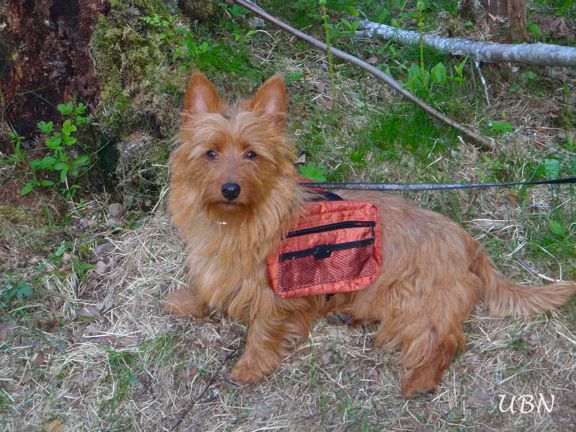
Vitterklippens Lindy-Sue
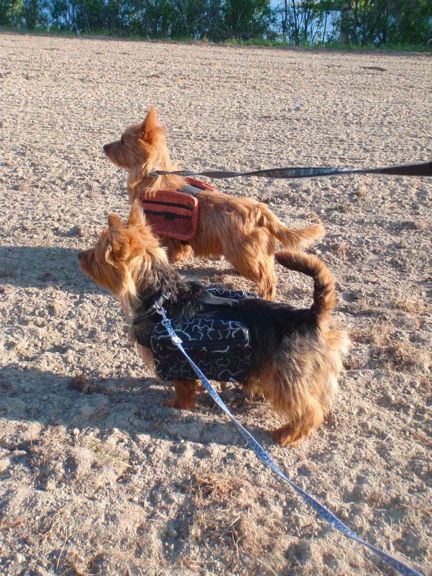
Vitterklippens Myran and Vitterklippens Lindy-Sue
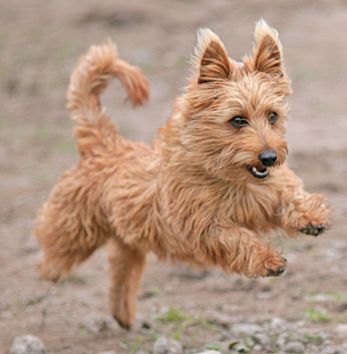
Vitterklippens Elijah
Owner and photographer: Benita Andersson

Minozzy Colombine "Maggie"

Vitterklippens Keira
Owner and photographer: Klöfver Mariah

"Nokia" Twee-Dle-Dee Connecting People
Owner: Ulla-Britt Norgren and
Vitterklippens Loke

Xita Av Falchebo Owner: Ulla-Britt Norgren
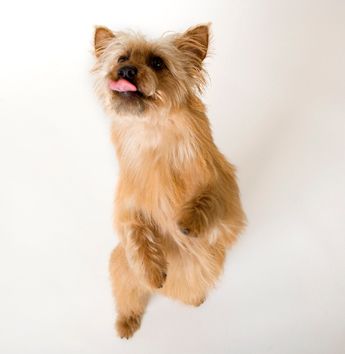
Vitterklippens Keira
Owner and photographer: Klöfver Mariah
|
"Tiger" The Agility Dog By Sanna Andersson | |
The first time agility was organized was as a show in an interval at Cruft's in 1978. The year after, 1979, it became an official dog sport in England. In Sweden agility was introduced in the middle of the 1980s, but it wasn't until March 1st, 1987, that it became an official dog sport. Today it is one of the most popular dog sports in Sweden, with around 70,000 starts every year.
The competitions are open for all dogs, pedigrees as well as mixed breeds. They just have to be over 18 months old. The dogs are divided into three different size classes, small, medium and large, and they compete against dogs of their own size.
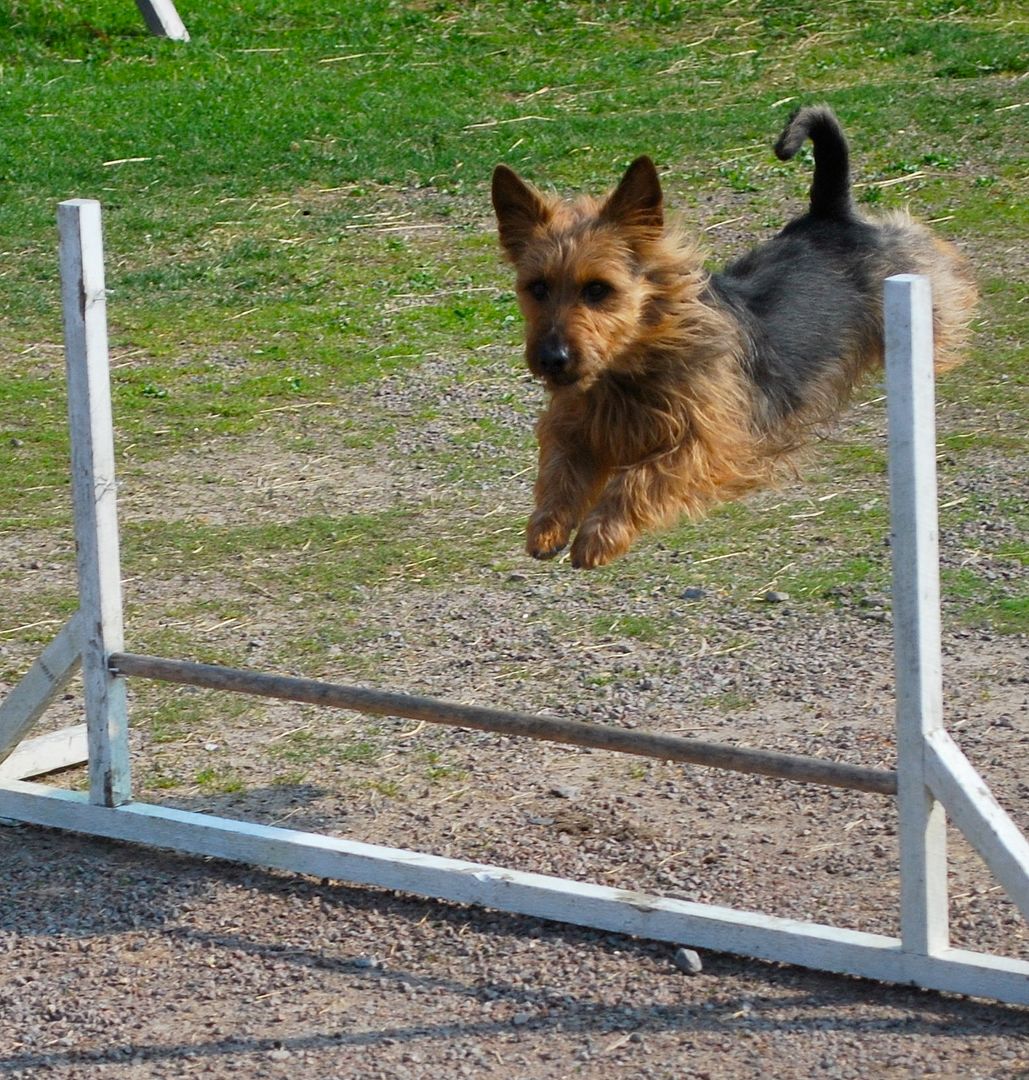
"Tiger"
In Sweden agility can be competed in official and unofficial competitions. The unofficial competitions are often open for everyone, regardless how experienced the equipages competitors) are, but there can be special classes, for example novices, but this is not so common.
In the official competitions there are three different classes, I, II and III. Class I is the easiest and required of everyone. When you have earned three promotion points you can, and have to, compete in class II. It is the same from class II to class III. To get a promotion point you have to do an error-free round and have a place among the 15% best equipages. It is the dog, not the equipage, which gets promoted. To qualify for the Swedish championships you have to get three promotion points in class III.
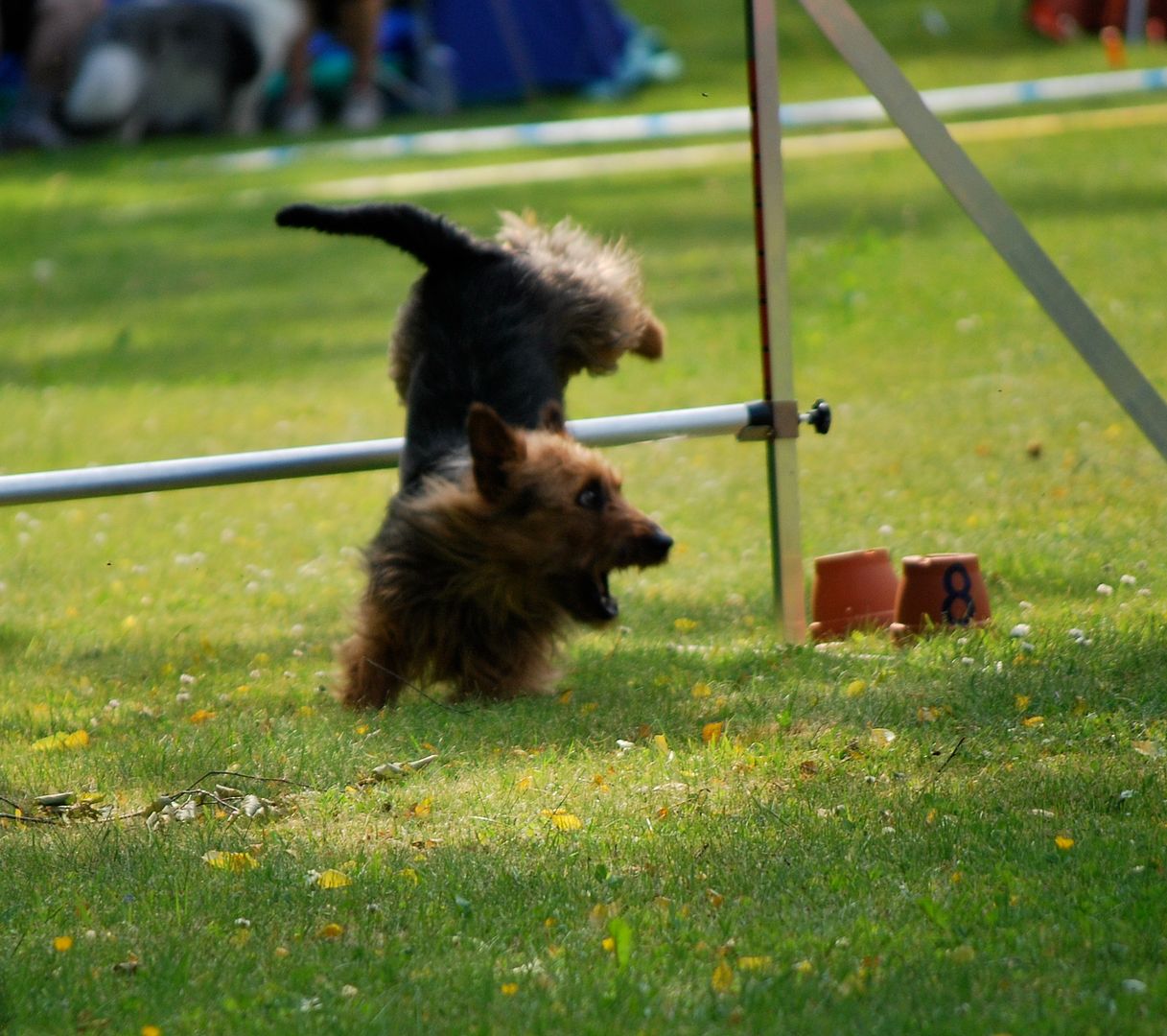
"Tiger" demonstrating his flexibility.
Agility can also be competed in teams with 3-4 dogs. In a team one handler cannot have more than 2 dogs.
My first contact with agility was around 10 years ago. At that time my family had Jack Russell Terriers, so the first dogs I did agility with were Jack Russell Terriers. All of them had their own ideas of how they should do agility and I can tell that their ideas often deviated from my ideas. The last Jack Russell I had, used to bite me when she thought that I was too slow or when she got frustrated.
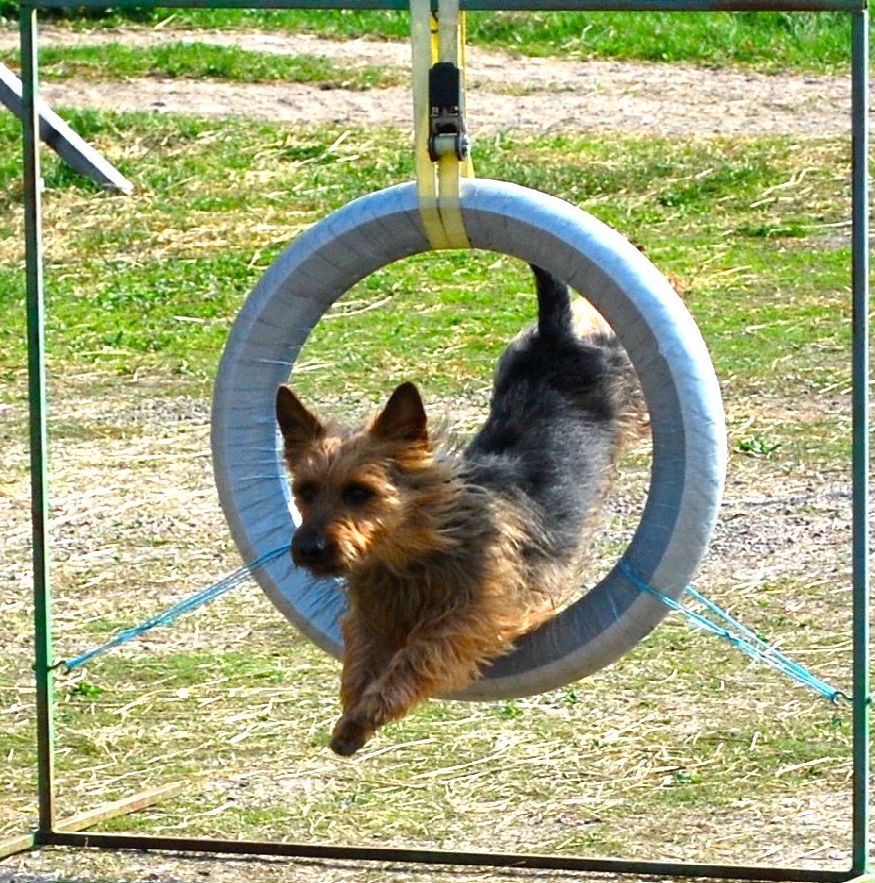
Today I have recently taken up agility again after a break and I have begun to train and compete a little with my mother's Australian Terrier called Tiger. My mother has attended two agility courses with him, the first one for beginners and the other one just a continuation of the first one.
We have only had time to compete twice, but he has been doing a great job. He is a little slow, but he is careful so most of our runs have been clear rounds, except from the time faults. It seems like he thinks that agility is tremendously fun. Tiger is my mother's dog, and he is almost obsessed with her, and wants to be with her all the time, but as soon as we start our run, he forgets everything about her and just focuses on the agility and me.

For me it is different handling him compared to the Jack Russell's. They were doing things first and thinking afterwards. Tiger thinks first and does things when he knows what he is supposed to do. He can get frustrated when he doesn't understand me, but he would never bite me.
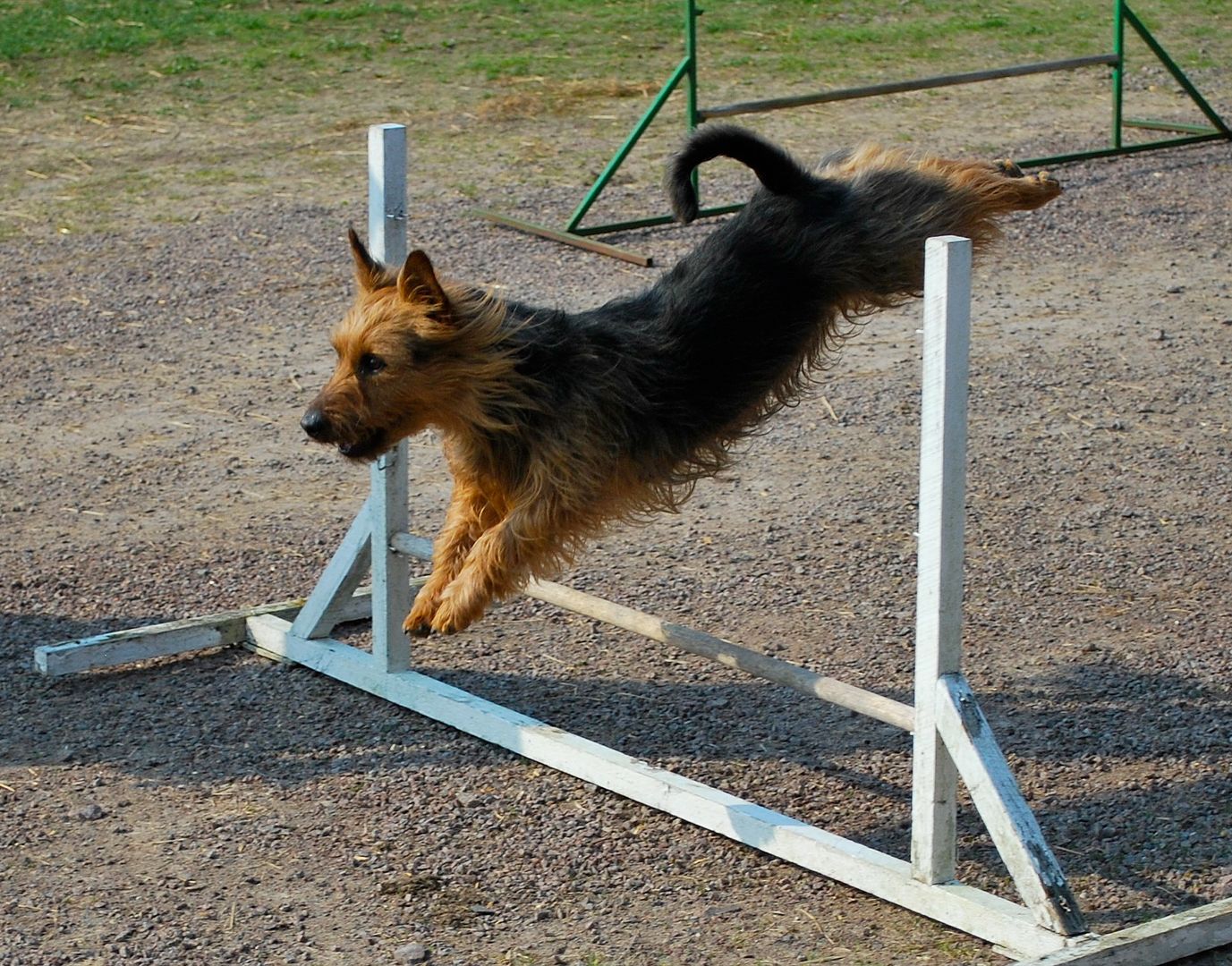
I have observed that the Australian Terriers I have seen doing agility have a characteristic technique when they are jumping over the hurdles. Unfortunately it's not a very good technique and it takes a lot of time for them. The long body of an Australian Terrier doesn't seem ideal for agility, but they can be very flexible. I have seen Tiger bend his body in the most peculiar ways when he is in the air, to prevent himself from knocking down a bar, or just for turning as quickly as possible.
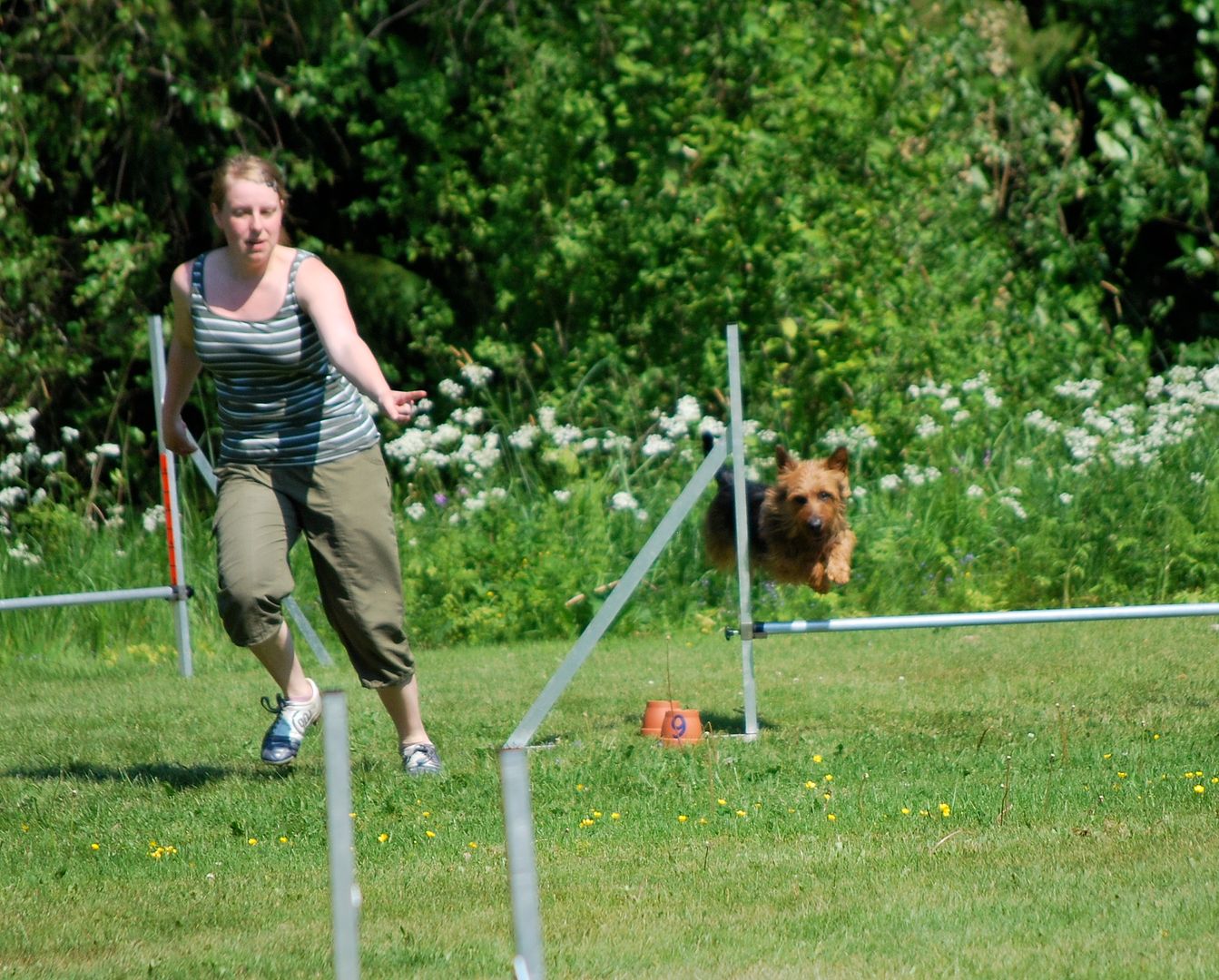
So would I say that agility is something for an Aussie? Yes, I surely would. I believe that an Aussie can do everything it has set its mind upon doing, and when agility is so fun, why wouldn't an Aussie want to do that?
I really hope that Tiger and I will have time to train agility this summer, and to compete. I'm also looking forward to training our young Aussie when he is old enough. Who knows, perhaps I will have two Aussies competing on the Swedish courses next summer.
|
|
Therapy Dogs In Sweden By Ursula Skanefors-Winbjörk
| |
Three Australian Terriers named, For Fun A King "Frasse", For Fun Boss "Boss" and Jaskarin Wild Red "Mister" in Northern Sweden "Gällivare" are included in the
project "Dogs for All".
In this program we want to create opportunities to socialize with dogs in an easy and safe way. We're currently visiting a few homes for the elderly and we visit facilities for disabled children. We hope to expand our operations and provide more opportunities for others to meet our dogs. The ability to use public areas in the lodging is small and slows down our progress
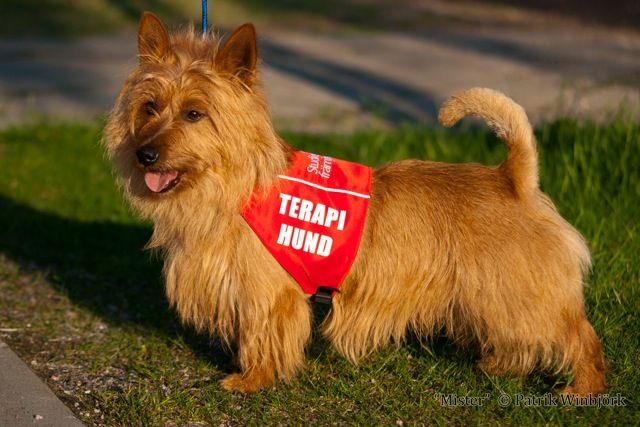
"Mister"
Our dogs have been tested to manage different kinds of life situations that can be unusual for them. A therapy dog works to increase the patients', residents' or students' motivation, well-being and health. The aim is to improve the quality of life with the visit. Studies have found that interaction with dogs in the form of touch, care and play leads to: Increased physical and mental activity
Increased motivation Well-being and calmness Faster and better rehabilitation Some of our project team have seen examples of older people who have been silent for a long time and then they suddenly start talking to the dog. An elderly woman decided not to wash herself before the next visit from "Frasse" because she got so many good kisses. Being able to bring joy in the simplest way is wonderful. 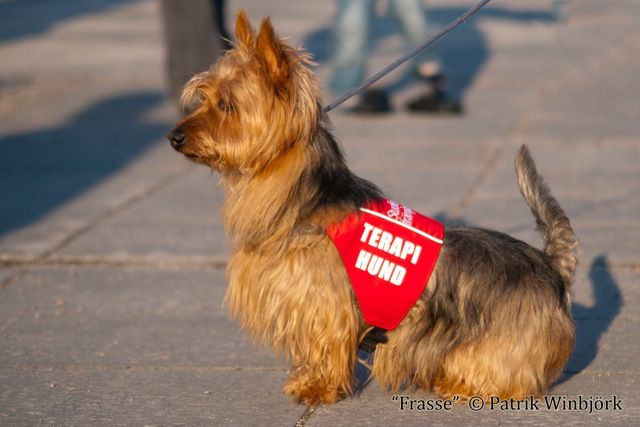
"Frasse" The dogs do not assess, they do not judge and they do not try to justify the calls for assistance or the contacts. The dogs are trained and must be strong enough to be pet and cuddled by strangers. To experience a warm body next to you or to be able to place your nose into soft fur should be a human right for everyone!
Ursula Skanefors-Winbjörk |
Australian Terrier as Rescue and Service Dog for Diabetics Written By: Leif Linder Translated By: Eva Malmsten | |
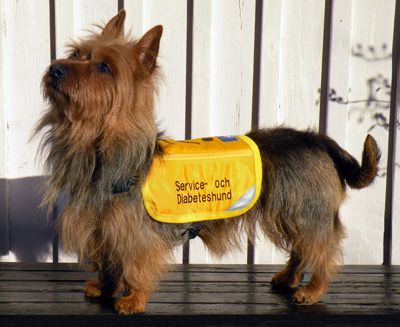
The little Aussie, Twee-dle-Dee Breakfast at Tiffany's,"Tiffany," has made a real achievement. She has now passed the tests and is the only Aussie in Sweden that is officially a Diabetes and Service Dog (perhaps also worldwide)!
Her owner, Leif Linder, explains: Becoming an approved and fully trained alerting service dog (diabetic dog) is not easy. It requires a long and thorough training. Training time is around 1 year and we started in October 2009. Before training begins, many application forms and certificates have to be completed. The dog should be HD-free (hip dysplasia free) and completely healthy otherwise. HD-X (x-ray) on an Australian Terrier may seem unnecessary, but those are the rules.
When the application is approved, there is an aptitude test, a variation of mental description. Then there is time for the three-day try-on Fetch and Carry, where theory is integrated with practical exercises and tests under the supervision of three instructors. "We were nine participants, of which three would become diabetic dogs," Leif informs.
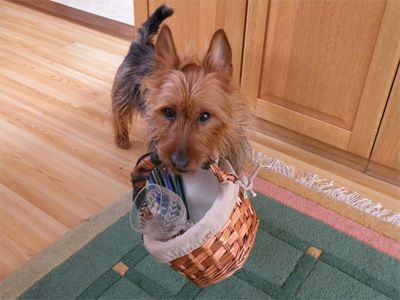
Tiffany helps with setting the table. Balance and precision is required.
Further Education
Six months later there is another three days of education to prepare for the final examination tests. A personal trainer is appointed to supervise and support the training. In scent training Tiffany will "alarm" when glucose levels begin to approach low or high values. "Never thought she could distinguish between different values, but she was fantastic!" Leif explains. The goal is that she will "tell" me before I start to feel bad."
Most obedience elements are included in the training, everything from Come to Heel to Go Fetch. "Tiffany has become a master at helping to set the table!" A big advantage of having a service dog, according to Leif, is that she can follow in places where dogs are not otherwise allowed to be. "We have been to IKEA and we even ate in the restaurant without any problems."

Tiffany at Scent Training
The organization which Leif and Tiffany belong to is called Swedish Service and Hearing Dog Federation (SoS). It is a non-profit organisation whose goal is to help people with a disability to train their dogs to be helpers in their lives. During the education time the dogs wear a red vest, which tells that they are in training. The vest means that the dog is working and should not be disturbed by people or other dogs, something that the owner is depending upon to be respected by the public.
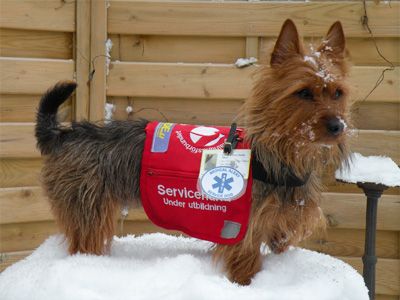
Outdoor Training
Final Examination
In October 2010 the education came to an end and it was time for the final examination. In a shopping mall full of people, six dogs and their handlers went through a series of tests to make sure that they were ready for certification. Among others the dogs were to stay on location for five minutes then find their hidden handlers, meet people and dogs without showing too much interest, retrieve car keys and other items, etcetera. Being able to be in places where otherwise the dog may not be allowed is of course important for a SoS dog.
The second part of the examination was an outdoors test in stormy weather with rain pouring down. Various obedience tests like Stay and Here were followed by a written test for the handlers.
The third part of the examination was "alerting." "Tiffany was to show that she can run and get help if I should get a severe hypoglycaemia," Leif explains. She was also to "tell" me when my blood sugar is low or high and to fetch a ringing phone. Soon she will be able to answer it I suppose ," Leif jests.
Tiffany passed all the tests with honour and is now the proud carrier of the yellow SoS vest that proclaims that she is a certified rescue dog. "When the protocol was compiled we got the yellow blanket, diploma, graduation cap to Tiffany and a jacket for me," Leif concludes. They are now allowed to visit most countries and even places where dogs are not normally allowed.
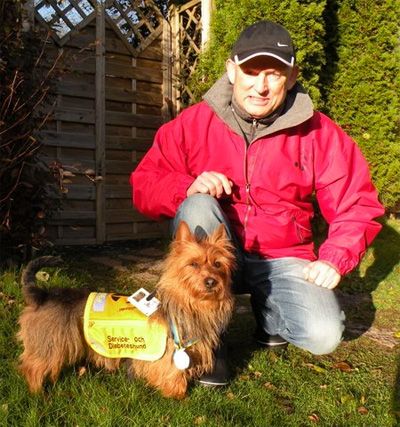
"Now I've graduated! I received a medal and everything!" (Tiffany and Leif Linder)
 Read more: http://www.soshund.se/ Read more: http://www.soshund.se/
|
My Recent Visit to Finland by Cheryl Mechalke | |
During my recent travel to Finland, I had the pleasure of attending two International Dog shows held on the 21st and 22nd of May, the Kansainvalinen Koiranayttely International Dog Show held at the Helsinki Ice Arena and at Hamina Bastioni, respectively.
Both shows were very interesting and there were many very nice Australian Terriers presented at each show. The first show was held in an event center, much like we have here in the U.S., with stadium seating above you and the dogs being shown on floors with mats.
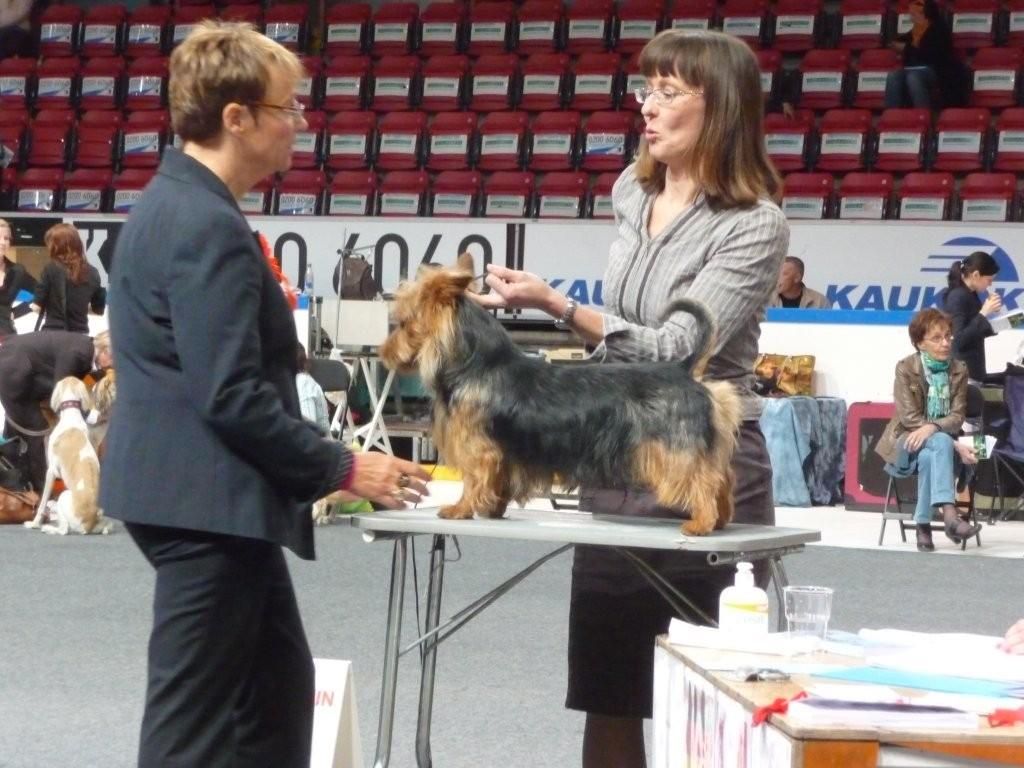
Helsinki Ice Arenaon - Kirsi Ola with Melukylan Sininen Supernova
May 21, 2011
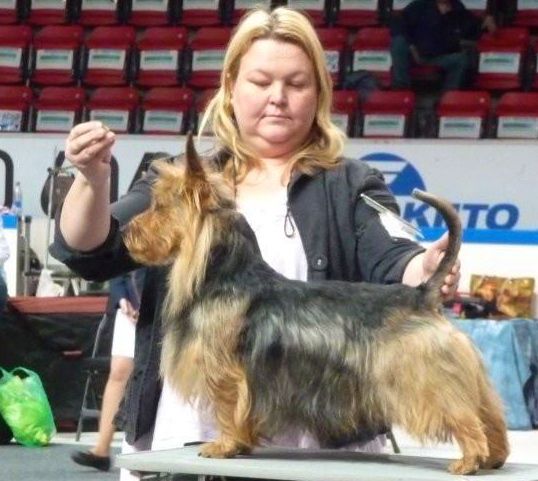
Krista Riihela with Remin Holy Diver
The second day of the International Show was an outdoor show, held at a historic Finnish site, which was very close to the coast line and offered a very different experience! The show was under a huge permanent tent on dirt and the surroundings were just magnificent! (I just marveled at how much the Denver International Airport looks like a copy of this lovely site!) This site had been a military strong hold along the coastline of Finland, which you can see in the photos. It has now been converted into an event center. As it is very near the coast line it can become very cool and windy at times, so everyone brings or dresses in layers. I even saw some in the show rings wearing winter coats!

Show Site Sunday

Many thanks to my wonderful tour guides, Irma & Satu Harden & Kirsi Ola!!
Here is an link to all show results in Finland. http://www.australianterrierikerho.fi/nayttelyt/tulos11.htm All photos Copyright and Courtesy Of Cheryl Mechalke |
US STATS Conformation | |
AKC Breed Stats through June 30, 2011

Photographer: Rich Bergman
1 GCH CH Ryba's Nothing But Blue Skies "Indy"

Photography by Kit
2 GCH CH Kambara's Zebulon "Zeb"

Photographer: Miguel Betancourt
3 GCH CH Black Back Firefly "Ringo"
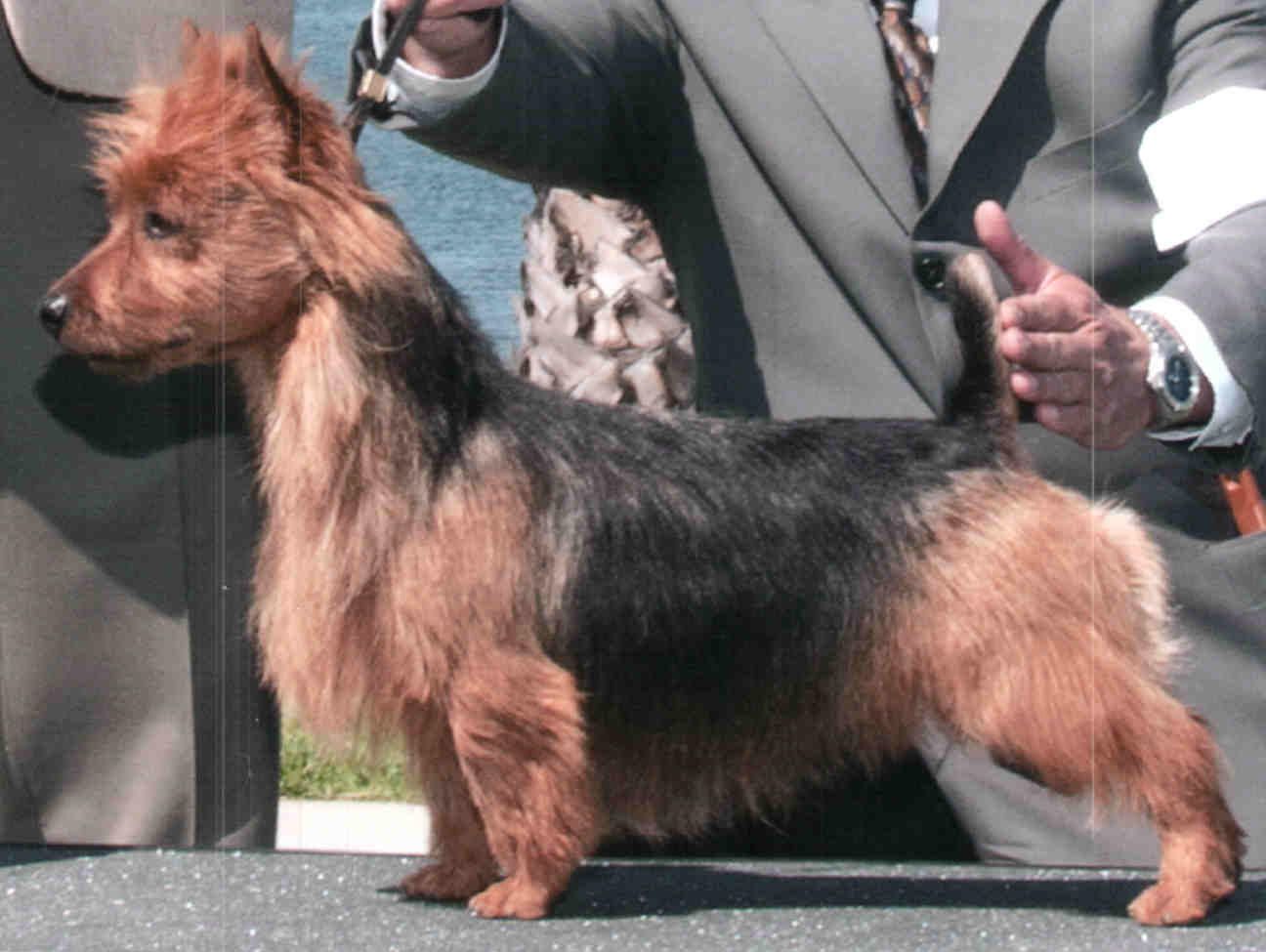
Photography by Kit
4 GCH CH Abq San Isidro Christhill "Izzy"

Photo Courtesy Of Lisa Weaver
5 GCH CH Benayr Clay Tucker "Tucker"
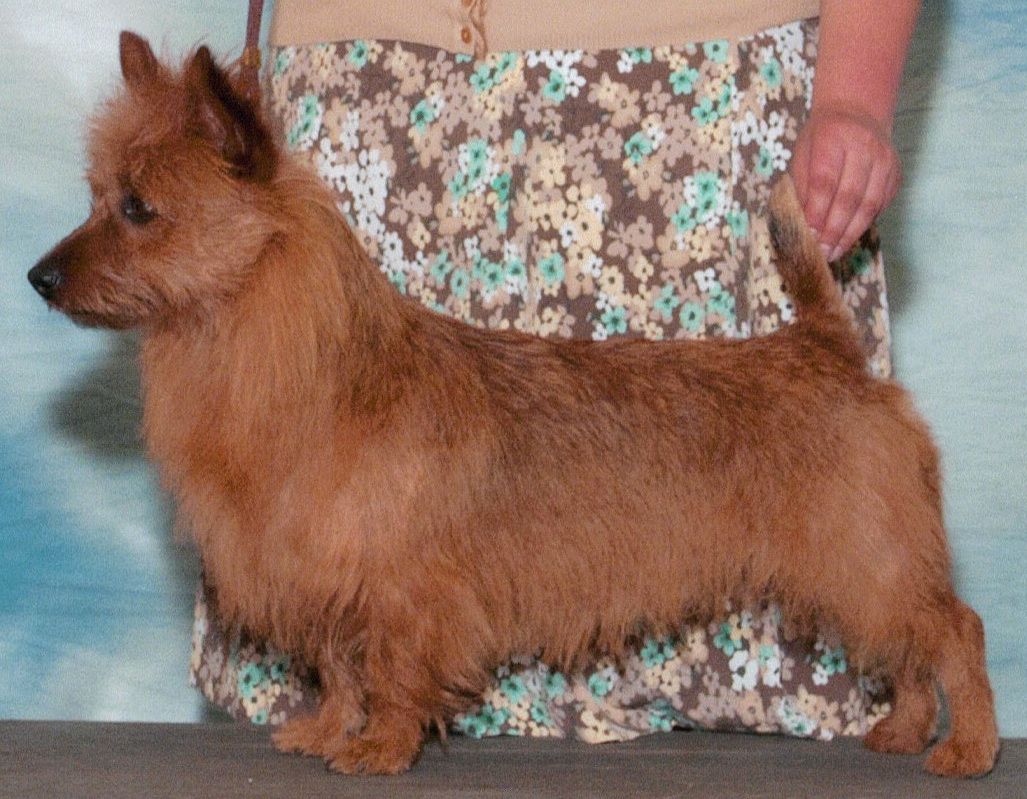
Photography by Holloway
6 GCH CH Nellyson's Mr Dont Skip The Zip "Zippy"
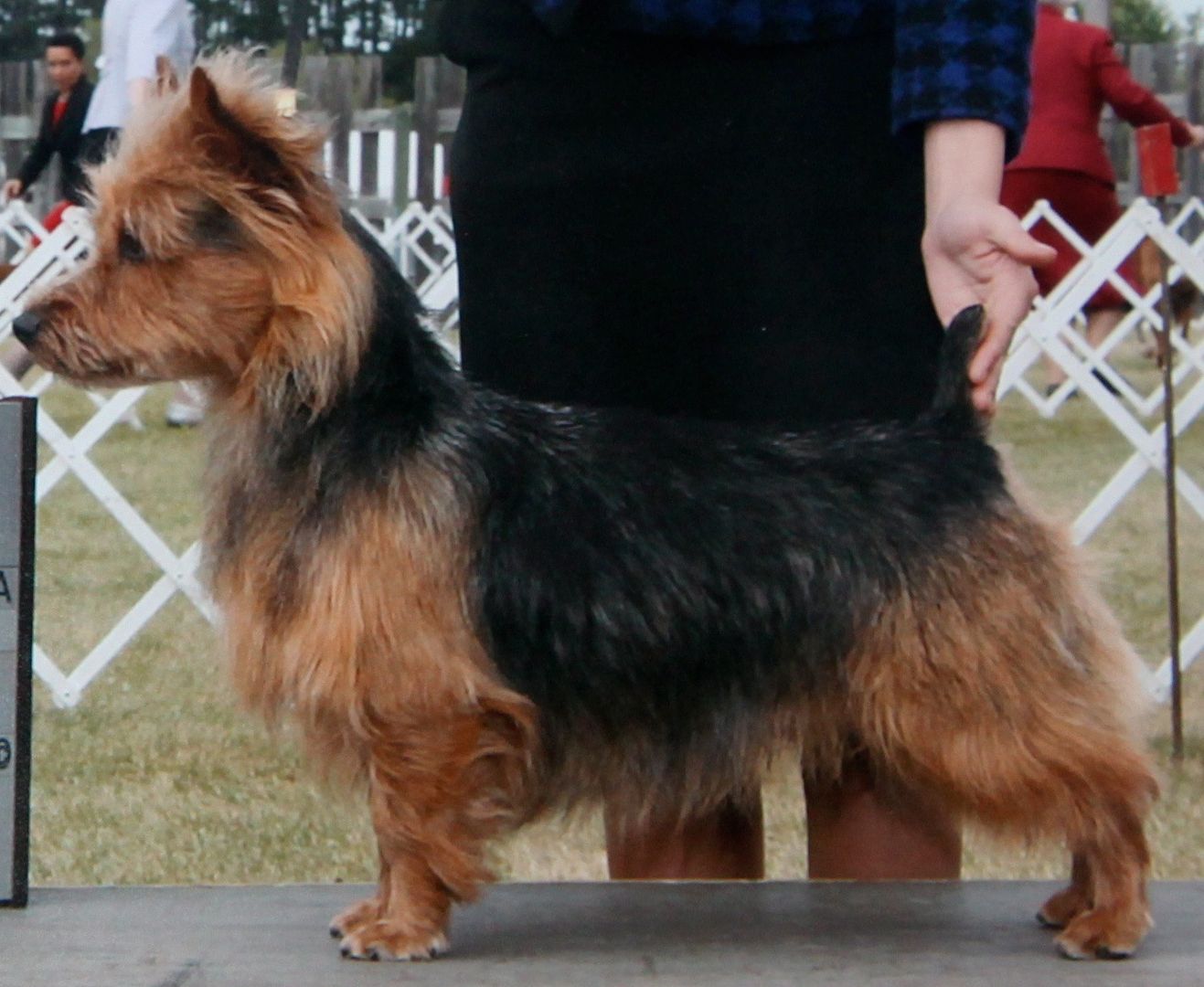
Photo courtesy of Jane Steinmetz
7 GCH CH Dunham Lake Scout Master "Scout
(Photo Unavailable)
8 GCH CH Aka Inu Story Teller
(Photo Unavailable)
9 CH Aka Inu Babu Apu
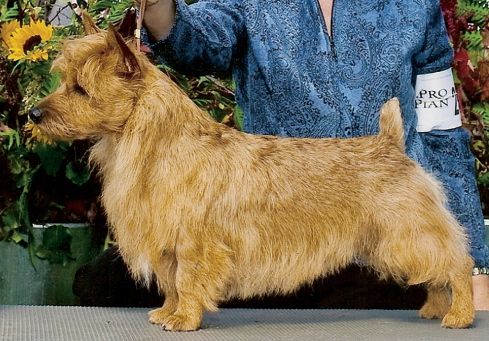
Photography by Perry Phillips
10 GCH CH Merrigangs Wild N Crazy Guy OA NAJ SE "Reggie"
Breed Points
1 GCH CH Ryba's Nothing But Blue Skies 169
2 GCH CH Kambara's Zebulon 145
3 GCH CH Black Back Firefly 85
4 GCH CH Abq San Isidro Christhill 84
5 GCH CH Benayr Clay Tucker 60
6 GCH CH Nellyson's Mr Dont Skip The Zip 59
7 GCH CH Dunham Lake Scout Master 39
8 GCH CH Aka Inu Story Teller 37
9 CH Aka Inu Babu Apu 35
10 GCH CH Merrigangs Wild N Crazy Guy OA NAJ SE 28
For More Stats you can Go To
Showsight Magazine
All Breed Points with Photos will be in the next issue.
|
Chef's Corner With Cheryl Mechalke | |
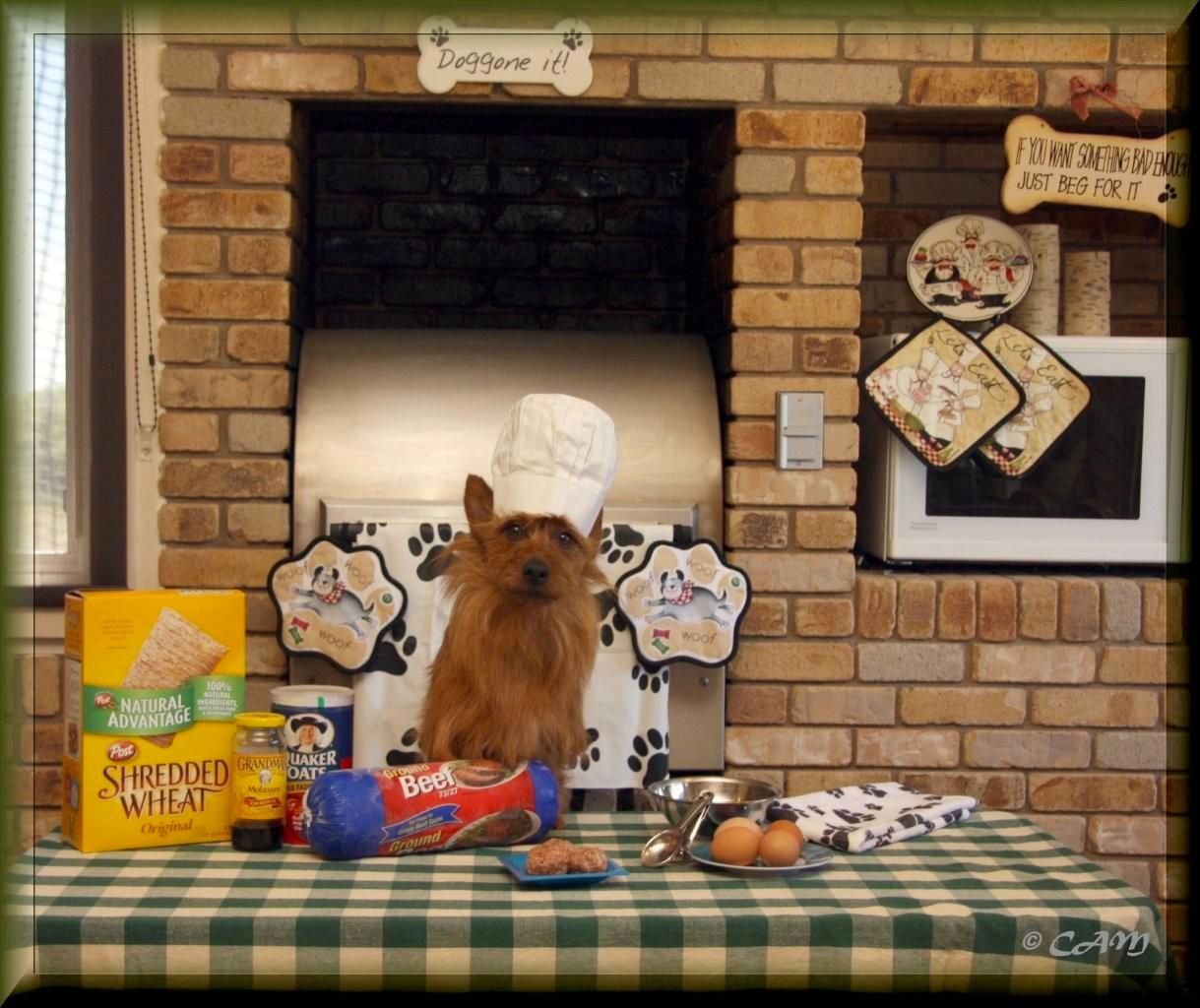
Photo Courtesy Of Cheryl Mechalke
1 lb. - raw ground beef - 500 grams
¾ cup- oats - 180 ml
1 biscuit of Shredded Wheat
1 egg
1 tablespoon- Molasses - 15 ml
Mix the raw beef, oats and crumbled shredded wheat all together in a large bowl. Add the egg and molasses then mix until all ingredients are combined. Then form into meatballs. Feed immediately or wrap, then refrigerate or freeze for future use. Makes about 12 medium sized meatballs. I make this recipe in bulk and freeze the meatballs in a single layer in a Ziplock plastic bag. Just pull out as many meatballs as you need to feed that day and leave in them in the refrigerator to defrost.
|
Do Aussies Smile? | |
Aussies do indeed smile or grin. This is one of the ways that research shows they demonstrate their happiness. They also wag their tail and get really bright eyes when they are happy.
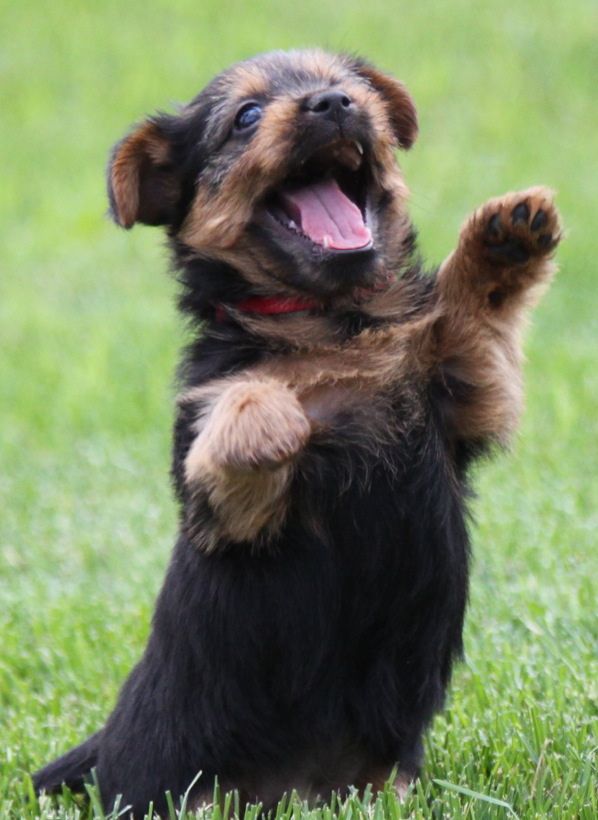
"Cheyenne" Goiffon
Elizabeth Marshall Thomas writes in The Hidden Life of Dogs: "All dogs smile, which is to say their faces become pleasant and relaxed, with ears low, eyes half shut, lips soft and parted, and chin high. This is a dog smile."

"Miles" Bustamante
"Yet a few dogs will also imitate human smiles. In the presence of human beings, these dogs will draw back their lips grotesquely to bare their teeth, making the same face as we make. At the same time, these dogs may also roll over to reveal their bellies submissively, showing they understand exactly what our smiles mean."
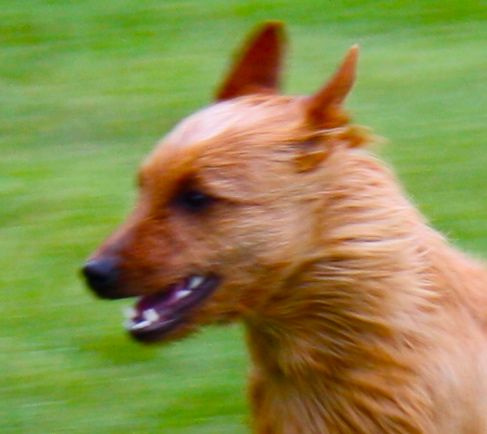
"Anya" Melton
Research demonstrates that dogs even laugh. To view this fascinating research and hear the sound of a dog laughing click here.
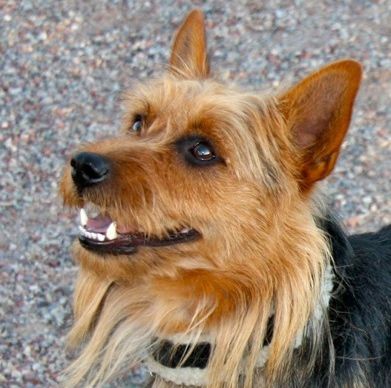
"Rocky" Levy
They also have a sense of humor. Sometimes, they play keep away, they do play bows to try and get you to play with them and they like to hide your things.
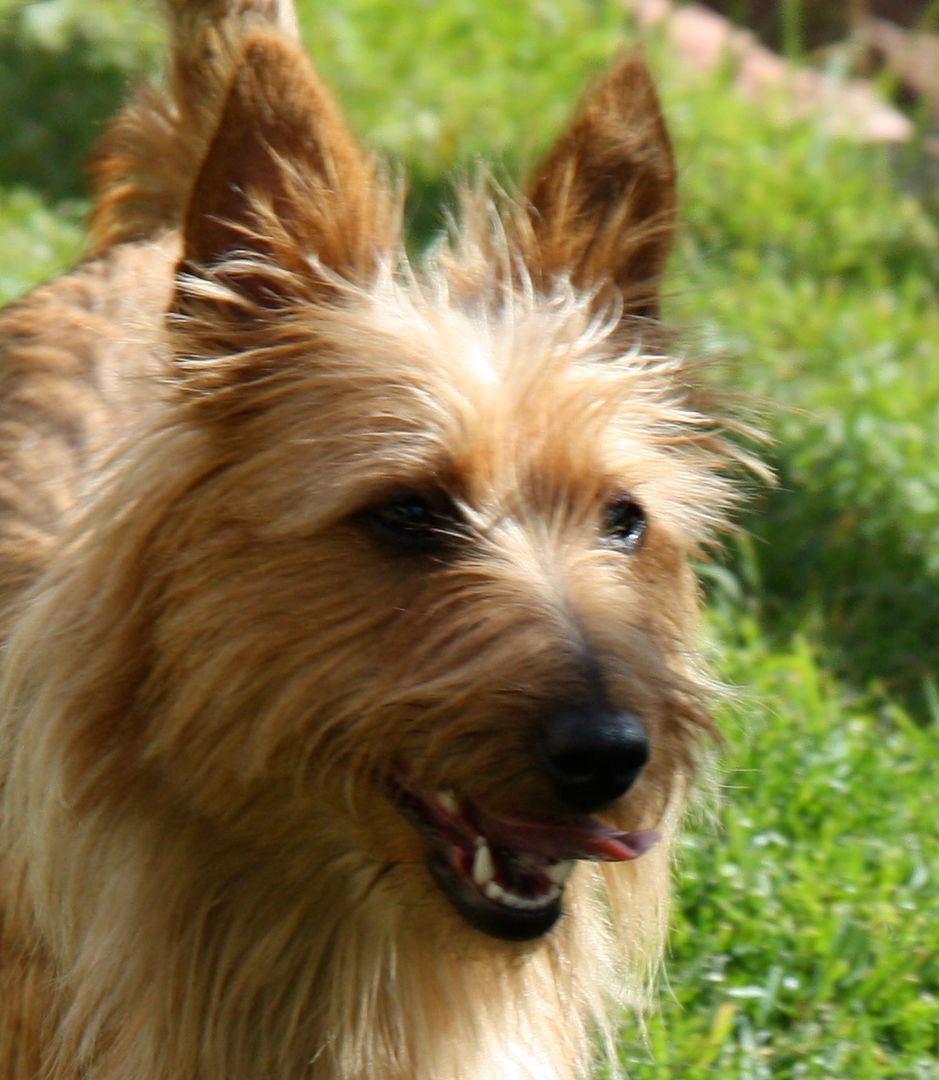
"Leila" Shear
Do you have a photo of your Aussie smiling?
Has your Aussie done anything that demonstrates his sense of humor? Please share your photos and stories with us.
click here

"Nacho" Jones
|
What I did this summer with my dog! | |
Please send us your story about what you did this summer with your dog. Please include photos. We will publish them in the next two newsletters.
Maybe you learned a new sport like earthdog, rally or agility. Maybe you went on a holiday with your family or went to a dog camp. Maybe you learned how to swim. Share your story with us!
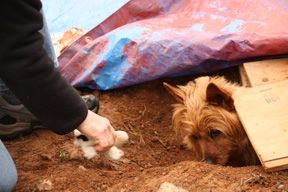
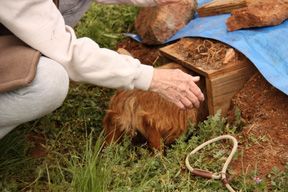
Learning how to do earth dog.
|
Feeding Your Aussie | |
Recently we asked our ATI facebook members how many times
a day they fed their dogs.
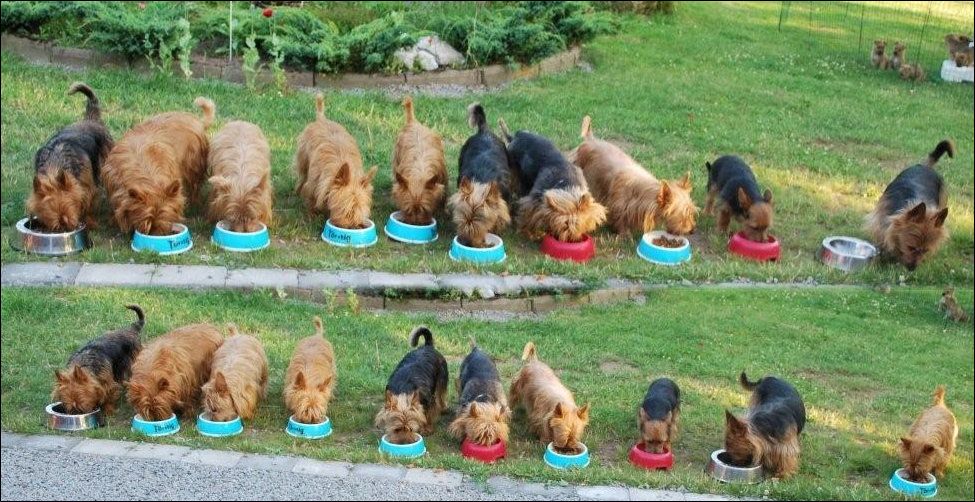
Photo Courtesy Of Tina Nordgren
Poorrmans Another Story "NELLIE"
Poormans Amorous Angel "INA"
Nellyson´s Bhalunsa Bruntotth "JUPPIE"
Nellyson´s Goody Goody "MINO"
Nellyson´s Need My Nightie "NATTIE"
Nellyson´s Red And Blue Baby Roo "EMMELI"
Nellyson´s Karrolina "PIPPI"
Devil In Disquise Av Falchebo "FISTER"
Tatong's Let The Music Play "MUSICA"
Here are the results.
Once a day-6%
I feed once a day to mimic the feeding pattern in the wild. Occasionally they have a fasting day (no food). They have a variety of raw food, lamb, beef, chicken, fish and pork occasionally.
Twice a day-81%
I feed twice a day. My 7 dogs eat in different places since some eat quick and some take a little longer, so all can eat in peace. Bowls are taken away after eating. I feel they are less hungry and more content eating twice a day.
Three times a day-6%
I feed 3 times a day. I give a small portion of dry dog food produced in Switzerland. It's a mix with a little pop rice and I add few cooked vegetable bits or apple bits raw (the vegetables not salted of course.) I mix the dry food with water and serve it immediately so it is still crunchy. I also give a chewing stick for clean teeth but not every day. She has always the same weight and perfect digestion. Our former Aussies often had problems with diarrhea until we fed dry dog food also mixed with water. Since then no problem. I watch closely where the dry food is produced and hope for the best to get good quality here in Switzerland.
Leave food out all the time-6%.
Pick up the food after 10-15 minutes.- 8%
There is never any food left to pick up!!!! - 91%
What are our dogs eating?
Our dogs get treats in between meals and their share of whatever is ready in the garden. Right now, that's strawberries and snap peas. They would probably like whipped cream on their strawberries, but I draw the line there.
They eat raw chicken, (a chicken leg generally) sweet potatoes, or whatever vegetable we eat. Before bed they have a chicken strip or venison beef jerky.
They love strawberries and raspberries. When in season, they help us harvest our raspberries. They literally eat them off the bush.
They like little carrots after dinner. Gave up on the garden as they ate the
tomatoes and strawberries as soon as they were ripe.
Since they are crated when I leave the house, they get CET dental chews, Sam's Yams treats, dental cookies, or Charlie Bears as cage treats. I usually have raw carrots with my lunch and I do share with them. They get a bit of canned pumpkin with breakfast and help me eat fruit snacks of apple, pear or blueberries. My dog has low grade chronic pancreatitis, so he is fed a low fat veterinary prescription diet by Royal Canin.
I give a raw egg including shell once every 10 days. I feed tinned pilchards in tomato sauce, some table scraps, occasional steamed vegetables, as well as, raw food, raw bones, chicken wings, pigs trotters, lamb ribs etc. Food is put down and
if not eaten in 5 minutes it is removed, but they always eat their food! I believe dogs do not need carbs. They get their calories from fat/protein.
Mine like to eat eggs or oatmeal in the am with blueberries, bananas, strawberries (all organic) or Grandma Lucy's re-hydrated food. They love organic carrots and apples as snacks.
ATI is not endorsing any food or diet. We are sharing information as to what other Aussie owners are feeding only. Before changing your diet you may wish to consult with your veterinarian.
|
CERF Testing | |

Photo Courtesy of Henny van den Berg
GREAT NEWS: APRIL 1-AUGUST 31, 2011, CERF tests mailed in to CERF will receive the kennel rate of $8.00 instead of $12.00. This is a wonderful savings. You must download the voucher here and send it in with your CERF paperwork. This is for everyone. If you have completed the CERF test but not filed it with CERF now is the time. If you have not tested your dogs eyes, please consider doing so.
To print the Voucher click here.
|
Favorite Videos | |

Photo Courtesy of Cheryl Mechalke
Walking on Sunshine
Dogs having a fun day at the beach. ( No Aussies in the video)
|
Favorite Products | |
Our ATI store will be caring these products soon!!!!!
Toys
The Cuz To view Aussies Playing With the Cuz Click Here
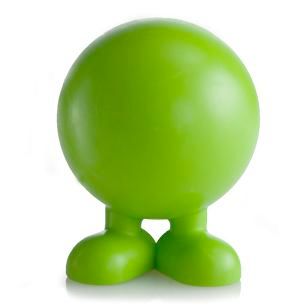
Furniture
Outdoor Patio Furniture For Your Dog Great Futon
For The Car
Co-Pilot Seat Cover by Kurgo

Backseat Bridge
This is a wonderful, brilliant product for your car. It gives your Aussie more room and with the seat down prevents you dog from slipping between the seats.
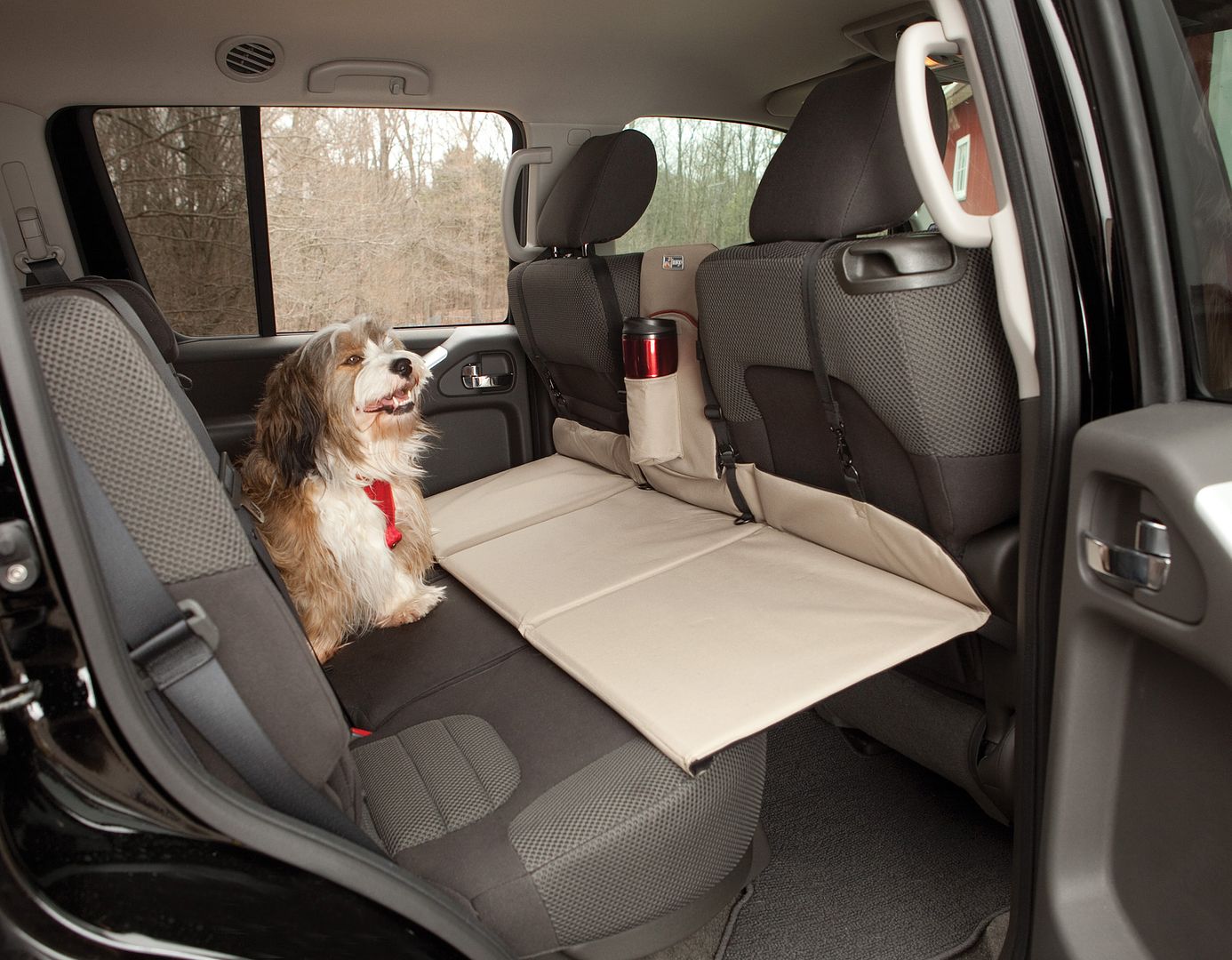
Made by Kurgo.
|
From The USA | |
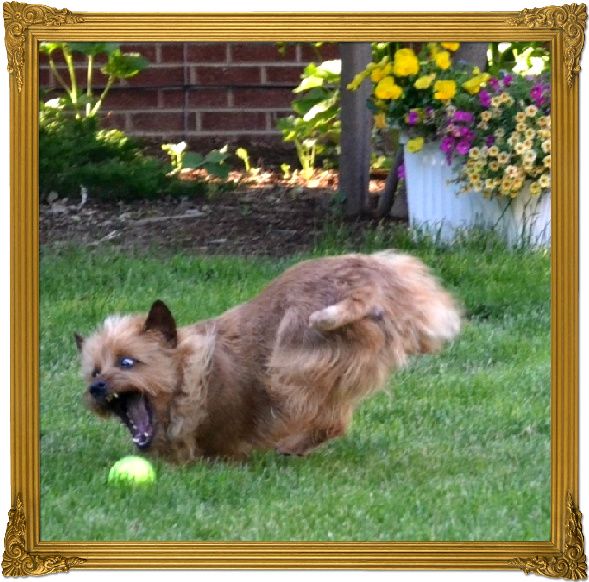
Photo By: Amber Bechtholdt
Fierce "Fergie" Strid
Juniors Are Our Future!
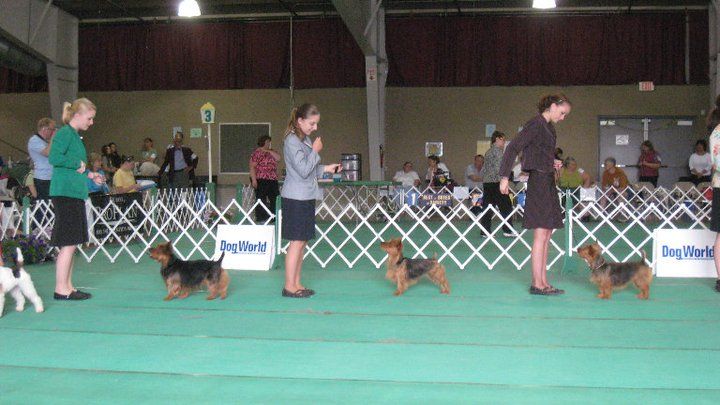
Photo and Information Courtesy of Kim Floyd
Here is a pic of the three Juniors with their Aussies. I am very proud of these girls!
Left to Right
Samantha Gray with AKC CH Akiba's Southern Exposure (UKC UWPV, UWPCH, USR, GRCH)
Christina Worley with AKC CH Johmanda's Delilah Ku'a (UKC GRCH)
Taylor Toms with AKC CH Kambara's Aviatrix RN, NAJ (UKC AGI, AGII, GRCH)
UWPV = United Weight Puller Versatile
UWPCH = United Weight Pull Champion
USR = United Steeple Racer
AGI = 1st level Agility (3 Q's)
AGII = 2nd level Agility (3 Q's)
GRCH = Grand Champion Conformation
|
Heartworm Information from Dr. Becker |
The American Heartworm Society has three "platinum" sponsors and five "bronze" sponsors. All eight are major pharmaceutical manufacturers. It comes as no surprise, then, that the AHS recommends year-round, birth-to-death heartworm prevention drugs - no matter where you live, the time of year, the age of your dog, his size or health status.
What's Wrong with This Picture?
Three things, specifically: -
Huge conflict of interest potential. Heartworm prevention through the overuse of potentially toxic medications sold by pharmaceutical giants like Bayer Healthcare, Merial and Pfizer, is a virtual money machine for drug manufacturers, online retailers, testing laboratories, veterinarians and any other entity that can find a way to cash in.
When there's money on the table - in this case billions of dollars - your pet's health and quality of life can quickly become a secondary concern.
Note also that the ASH recommendation for year-round dosing is not because your pet needs it year-round in every state, but because it's assumed dog owners will forget to re-start the medication when the weather warms up.
And by the way - heartworm "preventives" don't actually prevent your pet from getting worms. What they do is poison the larvae at the microfilaria (L1-L2) stage of development, causing them to die.
-
Relatively low actual incidence of life-threatening infection. Heartworm disease is more difficult to acquire - and less lethal - than the dire warnings and marketing claims for chemical preventives would have you believe.
In order for heartworm disease to take hold, a precise sequence of events must occur involving the right climate, the right temperature for the right amount of time, the right species and sex of mosquito, and your dog's less-than-optimal immune system function.
This information is not intended to minimize the need to protect your dog, but only to point out the actual potential for heartworm disease is less than you've been led to believe by financially-motivated marketing campaigns designed to scare pet owners into buying 12 doses of preventive, year in and year out, regardless of where you live!
- The existence of less toxic recommendations. There are less harmful protocols to prevent heartworm in your dog than a lifetime of once-monthly, year-round doses of toxic drugs.
How Heartworm Disease Happens
Heartworms are a variety of roundworm with the clinical name dirofilaria immitis. They are spread by mosquitoes. Dogs can only get heartworm disease through infected mosquitoes. They can't get it from other dogs or other types of animals, from dog feces, or from their mothers while in the womb or through nursing. Only certain mosquitoes can transmit heartworm to your dog. These mosquitoes must meet certain precise criteria, including: - They must be female.
- They must be of a species that allows development of the worms in the cells of the body (not all species do).
- They must be of a species that feeds on mammals (not all do).
- They must have bitten an animal infected with stage 1 (L1) heartworms about two weeks prior, since approximately 14 days are necessary for the larvae from the other animal to develop to stage 3 (L3) inside the transmitting mosquito.
This mosquito must then bite your dog. When the larvae reach stage L4-L5, which takes three to four months, under
the right conditions they can travel via your dog's bloodstream to the lungs and heart. If your dog's immune system doesn't destroy these invaders, they will reach maturity (L6), the adult stage, in which males can grow to six inches in length and females to 12. Two other critically important features in the transmission of heartworm are: - The right temperature. During the time the heartworm larvae are developing from L1 to L3 inside an infected mosquito, which is approximately a two-week period, the temperature must not dip below 57°F at any point in time. If it does, the maturation cycle is halted. According to Washington State University heartworm report from 2006, full development of the larvae requires "the equivalent of a steady 24-hour daily temperature in excess of 64°F (18°C) for approximately one month."
- Humidity and standing water. Mosquitoes are a rarity in dry climates.
As you can see, in order for your dog to develop heartworm disease, a number of things have to happen with near-perfect timing under a precise set of circumstances. Information on how many cases of canine heartworm disease occur each year in the U.S. is scarce. The AHS provides a heartworm incidence map for the years 2001, 2004 and 2007 which you might find helpful. Keep in mind it is a very general guideline and shouldn't be viewed as the only decision-making tool at your disposal.
Assessing Your Dog's Risk
There are only a few areas in the U.S. in which giving a nine month to year-round heartworm preventive might be advisable - those areas are in south Texas, south Florida, and a few other locations along the Gulf coast. The rest of the U.S. ranges from three to seven months of high exposure risk. The majority of states are at six months or less. Given that heartworm preventives are insecticides designed to kill heartworm larvae inside your animal, and therefore have the potential for short and long-term side effects damaging to your pet's health, the first bit of information you need is your dog's actual risk of exposure to infected mosquitoes. I recommend you talk to a holistic veterinarian in your area to get this question answered. If you don't have a holistic vet, you can find a directory at www.ahvma.org. Many holistic vets do phone consultations, which can be an alternative if there are no doctors practicing in your immediate area. A holistic vet will be knowledgeable not only about the risk of heartworm disease in your location, but also potential side effects of chemical preventives, and alternatives to over treating with these products, as well as suggesting detox options. And if the vet you consult has already seen or treated your dog, he or she will also be able to assess the risks and benefits for your particular situation.
First Things first
The next consideration is how to best protect your dog from heartworm disease with the least amount of impact to her overall health, including: - Feed a balanced, species-appropriate diet. The healthier your dog is, the less attractive she'll be to all types of pests and parasites, and the better able her immune system will be to fight off invaders. Parasites are more attracted to weak animals.
- And speaking of keeping her immune system healthy, take care not to allow your pet to be overloaded with toxins through unnecessary vaccinations and repeated courses of antibiotic or steroid therapy - two of the most overprescribed drugs in veterinary medicine.
- Control mosquitoes. Use a non-toxic insect barrier in your yard and around the outside of your home. Don't take your dog around standing water. Stay indoors at dawn and dusk. Make liberal use of a safe, effective bug spray.
Safe and Sane Heartworm Prevention
If you live in a region of the U.S. where mosquitoes are prevalent and you've determined your dog's risk of exposure to heartworm disease is high, my recommendations are:
- Go the natural route -- using heartworm nosodes and/or other homeopathic treatments and/or herbal/dietary supplements -- under the guidance of a holistic veterinarian, with heartworm testing every three to four months (checking more frequently is critical as all natural heartworm prevention doesn't guarantee your pet will never contract the disease).
- Providing your dog is healthy with good kidney and liver function, go with a chemical preventive at the lowest effective dosage (compounded if necessary for dogs that weigh at the low end of dosing instructions), at six (not four) week intervals, for the minimum time necessary during mosquito season.
- Don't use 'silver bullet' all-in-one products that prevent against every known GI worm and external parasite. If you use traditional heartworm preventives, the goal is to use the least amount of drug that successfully prevents heartworm. Using the heartworm 'plus' products, which unnecessarily deworm your pet monthly for GI parasites she doesn't have, are more drugs your pet doesn't automatically need.
- Follow up treatment with natural liver detox agents like milk thistle and SAMe, again with guidance from your pet's holistic vet. And don't add to your dog's toxic load by administering chemical flea or tick preventives during the same week.
- Calculate the month you need to begin (and discontinue) prevention based on temperatures in your area. Please view the charts for State to State guidelines: CLICK HERE
Dr. Becker is the resident proactive and integrative wellness veterinarian of HealthyPets.Mercola.com. You can learn holistic ways of preventing illness in your pets by subscribing to
MercolaHealthyPets.com
, an online resource for animal lovers. For more pet care tips, subscribe for FREE to
Mercola Healthy Pet Newsletter
Thank you ATI Member Debby Miller for sharing the information on heartworm and encouraging the story.
ATI is sharing information only.
Please consult with your personal vet before making any changes for your dog.
|
National Association For Canine Scent Work | |
What is K9 Nose Work?
K9 Nose Work is the specific sport created and sanctioned by the National Association of Canine Scent Work (NACSW). This sport was inspired by the training methodology of detection K9s and borrows elements of that training for recreation. The terms nose work, fun nose work, scent work, search work are all commonly used references to describe any activity where the dog is using its nose to locate a target scent or odor. K9 Nose Work is the term that defines this detection inspired sport that has evolved from the pursuit of many dogs (with their handlers) to practice nose work and have fun.
One of the many challenges faced by working K9s and their handlers is encountering new environments and scenarios daily. This challenge will be reflected in the sport through differing search environments and requirements of each trial location.
To view dogs learning to do the scent work Click Here |
|
Digital AKC Gazette
| |
The AKC will no longer be publishing the AKC Gazette in its present form after September. Beginning with the October 2011 issue they will have a free online electronic PDF format. You will be able to access it by going to www.akc.org
July Issue
June issue
May issue
|
Bark Out! | |
Oh, I just love every edition!! Sometimes I find myself getting a bad case of "Aussie envy" but then I just count my blessings (which are so many) and I know I will own another Aussie again someday when the timing is right. Meanwhile, I can DROOL over these wonderful Aussies and learn so much while I am at it. I loved reading the history of this wonderful breed in the UK. So great. Beverly Powell
__________________________
I have no clue how you find and prepare all the material you do for ATI. Just wonderful. Great job! Chuck Bessant
_________________________
I had a chance to look at the newsletter and thoroughly enjoyed reading it. We don't get many newsletters in UK these days and so it was really good to sit down with my coffee and enjoy reading all the articles and looking at the pictures.Well done to you and everyone who has been involved and a thank you for producing it for us. I was delighted to help. Lynn Bell
__________________________
Thank You! Thank You! Thank You! Sprite's article came out great.
Thanks again! Georgette LaPorte
__________________________
I love the newsletter and I love Australian Terriers. I met my first Aussie puppy about 10 years ago and was confused because I thought it was black and tan Cairn. I quickly feel in love with this rarer breed and did my research. They are such smart and wonderful little dogs. I really enjoyed reading this article. You guys are very passionate and dedicated to your breed, I love it! We really appreciate the FitPAWS® segment in this article. Thank you so much for the international FitPAWS recognition, this really means a lot to us. Having a strong core will prevent injury and improve performance. Thanks again for your support,
Check out the
terrier video
from TOPS:
- FitPAWS® 20" wobble board Terrier Demo video
Catherine Rios
FitPAWS Specialist
Ball Dynamics International, LLC
|
Join ATI | |
WE HOPE YOU'VE ENJOYED THIS NEWSLETTER
AND WILL JOIN US.
WITH YOUR PAID MEMBERSHIP YOU WILL GET ACCESS TO THE WEBSITE, BE ABLE TO DOWNLOAD FREE ARTICLES, GET THE LATEST NEWS ON VACCINE PROTOCOLS, BE ABLE TO SHOP IN THE AUSTRALIAN TERRIER MARKET AND SO MUCH MORE. To Join Click here The cost is $20 a year. You can also join our Group Australian Terrier International on Facebook! |
|
|
|
|
|
|